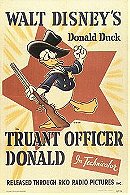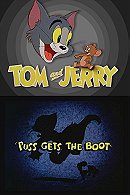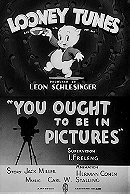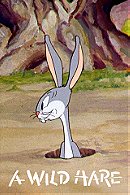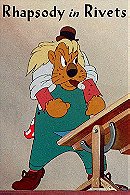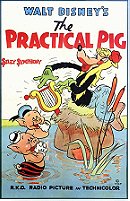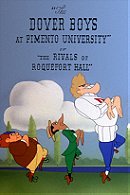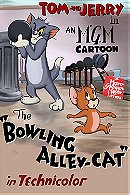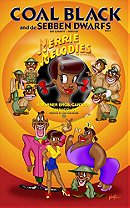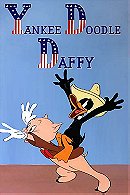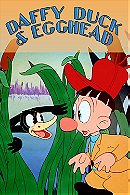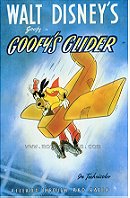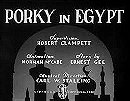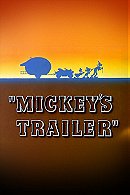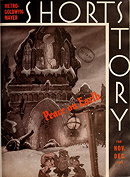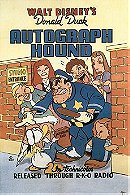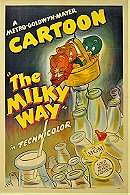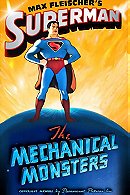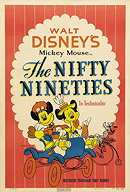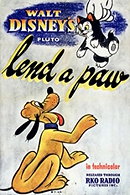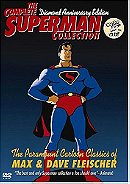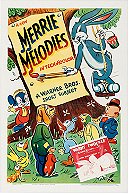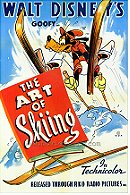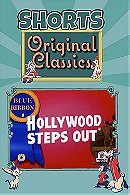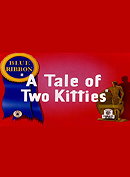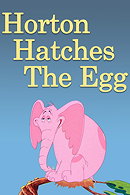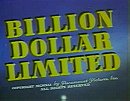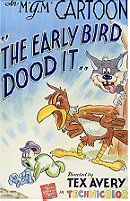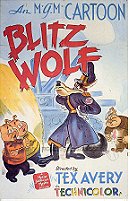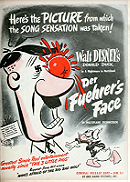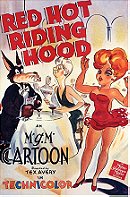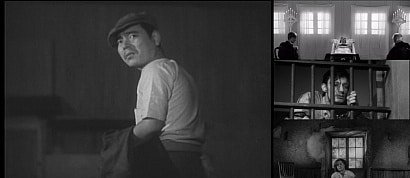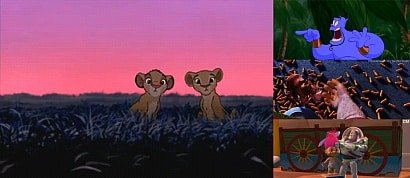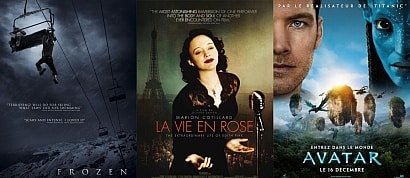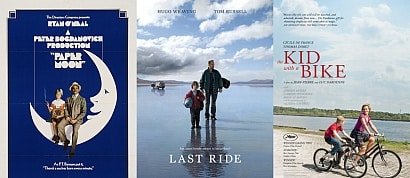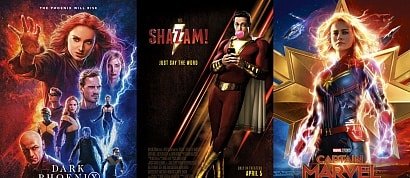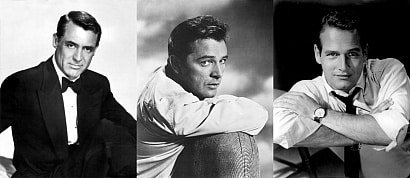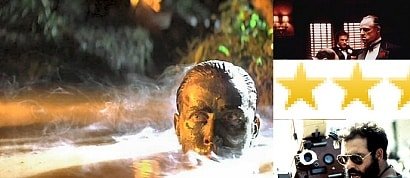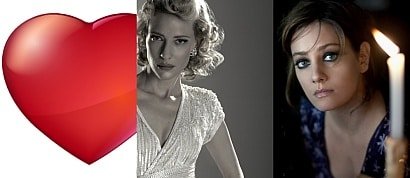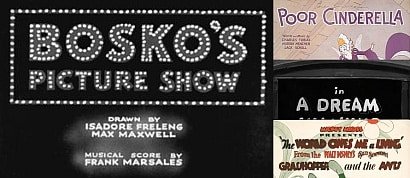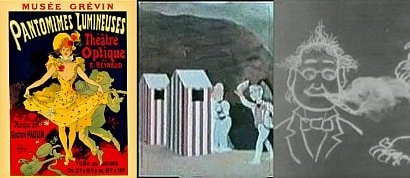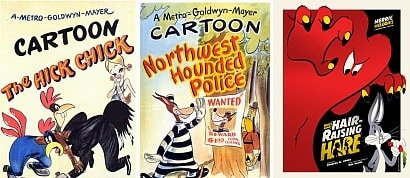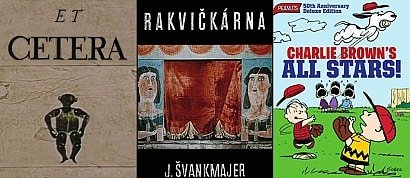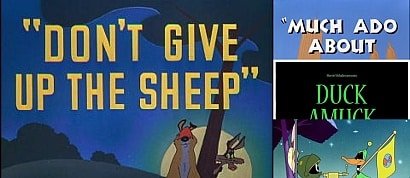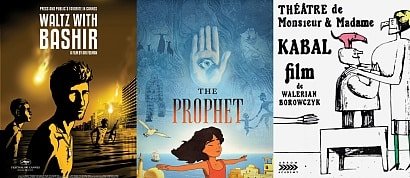1001 Animated Shorts You Must See - Part 3
Sort by:
Showing 50 items
Decade:
Rating:
List Type:
DIR: Tex Avery
SUMMARY: A spoof of the great Warner gangster films of the 30s.
WHY IT'S HERE:Tex Avery's 'Thugs With Dirty Mugs' is one of the director's great classics. Though less discussed than many of Avery's pictures, 'Thugs With Dirty Mugs' is a masterclass in parody and the visual gag. In fact, there are so many extraordinarily inventive and original sight gags on offer here that you can't quite believe Avery packs them all into seven minutes. The main concept of the cartoon is a parody of all those great Warner Bros. crime movies of the time (the main villain is a caricature of Edward G. Robinson) and this is observed wonderfully but instead of focusing on plot, 'Thugs With Dirty Mugs' quickly establishes itself as a series of spot gags with a loose cops and robbers throughline. Spot gag cartoons can sometimes be slow moving or hit and miss but 'Thugs With Dirty Mugs' has a ridiculously high hit rate and moves at such a lick that the few misses barely register. I don't want to spoil any of the gags by describing them here but 'Thugs With Dirty Mugs' features one of the best and silliest sight gags in history. Just listen out for the phrase "Take that you rat" and you'll see what I mean. One of the all-out funniest shorts in the entire Warner library, 'Thugs With Dirty Mugs' is a classic which everyone should make the effort to see.
SUMMARY: A spoof of the great Warner gangster films of the 30s.
WHY IT'S HERE:Tex Avery's 'Thugs With Dirty Mugs' is one of the director's great classics. Though less discussed than many of Avery's pictures, 'Thugs With Dirty Mugs' is a masterclass in parody and the visual gag. In fact, there are so many extraordinarily inventive and original sight gags on offer here that you can't quite believe Avery packs them all into seven minutes. The main concept of the cartoon is a parody of all those great Warner Bros. crime movies of the time (the main villain is a caricature of Edward G. Robinson) and this is observed wonderfully but instead of focusing on plot, 'Thugs With Dirty Mugs' quickly establishes itself as a series of spot gags with a loose cops and robbers throughline. Spot gag cartoons can sometimes be slow moving or hit and miss but 'Thugs With Dirty Mugs' has a ridiculously high hit rate and moves at such a lick that the few misses barely register. I don't want to spoil any of the gags by describing them here but 'Thugs With Dirty Mugs' features one of the best and silliest sight gags in history. Just listen out for the phrase "Take that you rat" and you'll see what I mean. One of the all-out funniest shorts in the entire Warner library, 'Thugs With Dirty Mugs' is a classic which everyone should make the effort to see.
DIR: Dick Lundy
SUMMARY: Donald Duck goes to a penny arcade where he finds that the 'good time for a dime' that is promised is harder to come by than you might expect.
WHY IT'S HERE: 'A Good Time for a Dime' is a delightful little short that gives us a nostalgic glimpse into the world of the penny arcade. But it is also further proof that Donald Duck was a strong enough character to support a whole seven minute cartoon entirely solo. Unlike Mickey, who needed the action packed stories or myriad co-stars to bring out the best in him, Donald's mix of boyish excitement and explosive frustration makes him entertaining enough alone. In fact, Donald was often funniest when he was being wound up by trivial little trials of life, rather than by a living, breathing heckler. Though Donald's encounters with a crane machine and an airplane ride are both inspired, perhaps the most striking moment in the short is the opening gag in which he tries to watch a risqué peepshow of the Dance of the Seven Veils. This kind of lascivious sexual content (Donald's shadow morphs into the devil as he droolingly looks on), though occasionally present in earlier shorts, was rarer in Disney cartoons of this era but it works with Donald's feint whiff of the frustrated adolescent. This angle was taken to alarming lengths in the underrated Disney headtrip of a feature 'The Three Caballeros', in which Donald is positively sex crazed and pursues a range of human women with aggressive persistence.
SUMMARY: Donald Duck goes to a penny arcade where he finds that the 'good time for a dime' that is promised is harder to come by than you might expect.
WHY IT'S HERE: 'A Good Time for a Dime' is a delightful little short that gives us a nostalgic glimpse into the world of the penny arcade. But it is also further proof that Donald Duck was a strong enough character to support a whole seven minute cartoon entirely solo. Unlike Mickey, who needed the action packed stories or myriad co-stars to bring out the best in him, Donald's mix of boyish excitement and explosive frustration makes him entertaining enough alone. In fact, Donald was often funniest when he was being wound up by trivial little trials of life, rather than by a living, breathing heckler. Though Donald's encounters with a crane machine and an airplane ride are both inspired, perhaps the most striking moment in the short is the opening gag in which he tries to watch a risqué peepshow of the Dance of the Seven Veils. This kind of lascivious sexual content (Donald's shadow morphs into the devil as he droolingly looks on), though occasionally present in earlier shorts, was rarer in Disney cartoons of this era but it works with Donald's feint whiff of the frustrated adolescent. This angle was taken to alarming lengths in the underrated Disney headtrip of a feature 'The Three Caballeros', in which Donald is positively sex crazed and pursues a range of human women with aggressive persistence.
DIR: Jack King
SUMMARY: In his role as Truant Officer, Donald Duck attempts to force his nephews to attend school.
WHY IT'S HERE: This enjoyable Oscar nominated cartoon features Donald Duck and his nephews Huey, Dewey and Louie. The three little ducks, who had also appeared in the Oscar nominated but not-as-good 'Good Scouts', were rapidly becoming popular foils for Donald in place of his former co-stars Mickey and Goofy. Though the Huey, Dewey and Louie shorts never reach the levels of quality of the Mickey, Donald and Goofy cartoons, Donald's nephews warrant at least one appearance on this list and 'Truant Officer Donald' is perhaps the cream of the crop. This cartoon is also particularly notable for a dark little gag involving some cooked chickens which lead Donald to believe he has accidentally cooked his nephews alive. Although this kind of slightly morbid joke is not something readily associated with Disney, its like appeared surprisingly often, perhaps most horrifyingly in 'Squatter's Rights', which ends with Mickey Mouse believing that a ketchup covered Pluto has been shot. The iris closes before he realises the truth, leaving him to run off desperately cradling what he believes to be Pluto in his death throes. Hilarious!
SUMMARY: In his role as Truant Officer, Donald Duck attempts to force his nephews to attend school.
WHY IT'S HERE: This enjoyable Oscar nominated cartoon features Donald Duck and his nephews Huey, Dewey and Louie. The three little ducks, who had also appeared in the Oscar nominated but not-as-good 'Good Scouts', were rapidly becoming popular foils for Donald in place of his former co-stars Mickey and Goofy. Though the Huey, Dewey and Louie shorts never reach the levels of quality of the Mickey, Donald and Goofy cartoons, Donald's nephews warrant at least one appearance on this list and 'Truant Officer Donald' is perhaps the cream of the crop. This cartoon is also particularly notable for a dark little gag involving some cooked chickens which lead Donald to believe he has accidentally cooked his nephews alive. Although this kind of slightly morbid joke is not something readily associated with Disney, its like appeared surprisingly often, perhaps most horrifyingly in 'Squatter's Rights', which ends with Mickey Mouse believing that a ketchup covered Pluto has been shot. The iris closes before he realises the truth, leaving him to run off desperately cradling what he believes to be Pluto in his death throes. Hilarious!
DIR: Joseph Barbera, William Hanna
SUMMARY: When a cat named Jasper is told by his owner that he will be thrown out of the house if he causes one more breakage, a little mouse decides to take advantage of this.
WHY IT'S HERE: William Hanna and Joseph Barbera would go on to become two of the biggest names in animation, creating a barrage of beloved TV characters including The Flintstones, Huckleberry Hound and Yogi Bear. Much as I loved these later creations, it was undoubtedly with their early theatrical work as a team that Hanna and Barbera created their masterpieces. Teaming up to direct 'Puss Gets the Boot', they inadvertently created two of American animations most enduring characters. Although here the cat was called Jasper and the mouse was nameless, with their second appearance in a cartoon called 'The Midnight Snack' they became known as Tom and Jerry.
'Puss Gets the Boot', the official first appearance of Tom and Jerry, is a bit rough around the edges compared to later efforts but it is still extremely entertaining beyond its historical importance. Tom, as Jasper, has a slightly different, more scraggly and less handsome design, while Jerry is far more similar to the character we all know. But right from the start the relationship is established clearly and a chase that would last decades begins.
SUMMARY: When a cat named Jasper is told by his owner that he will be thrown out of the house if he causes one more breakage, a little mouse decides to take advantage of this.
WHY IT'S HERE: William Hanna and Joseph Barbera would go on to become two of the biggest names in animation, creating a barrage of beloved TV characters including The Flintstones, Huckleberry Hound and Yogi Bear. Much as I loved these later creations, it was undoubtedly with their early theatrical work as a team that Hanna and Barbera created their masterpieces. Teaming up to direct 'Puss Gets the Boot', they inadvertently created two of American animations most enduring characters. Although here the cat was called Jasper and the mouse was nameless, with their second appearance in a cartoon called 'The Midnight Snack' they became known as Tom and Jerry.
'Puss Gets the Boot', the official first appearance of Tom and Jerry, is a bit rough around the edges compared to later efforts but it is still extremely entertaining beyond its historical importance. Tom, as Jasper, has a slightly different, more scraggly and less handsome design, while Jerry is far more similar to the character we all know. But right from the start the relationship is established clearly and a chase that would last decades begins.
DIR: Friz Freleng
SUMMARY: Egged on by Daffy Duck, who intends to take his place as Warner Bros. star character, Porky Pig sets off into a live action Hollywood to make his name in the movies.
WHY IT'S HERE: Friz Freleng's 'You Ought to be in Pictures' is a brilliant, atypical Warner Bros. cartoon. Beautifully combining animation and live action film (only Porky Pig, Daffy Duck and Porky's car are animated), it stars many of the Warner staff, including Leon Schlesinger who, despite playing himself, manages to be hammier than the pig he's acting opposite! While the animators at the Warner Bros. studio are out at lunch, the newly drawn Daffy Duck convinces the newly drawn Porky Pig that he deserves better than a career in animation and sets him on his way to seeking a starring role in the movies. His motives, of course, are to get rid of Porky so that he can take his place as Warner's big star. An early glimpse of the greedy, narcissistic version of Daffy (as opposed to the crazy version of Daffy more commonly seen in these early black and white shorts), this is also another clear case of Daffy stealing the cartoon, something that would lead to life imitating art as Daffy really did replace Porky as Warner's most popular star. Porky's trip to a movie studio and his high speed chase through the streets to get his job back make 'You Ought to be in Pictures' seem more epically expansive than the average short of this era and the interaction between real life and animation is surprisingly smooth for such an early example of the two mediums coexisting. All in all, 'You Ought to be in Pictures' is a fascinating, entertaining short which is extremely easy to love. Ironically, having achieved his aim of replacing Porky as a comedy star, Daffy would be complaining of being typecast as a comedy player just ten years later in Chuck Jones's 'The Scarlet Pumpernickel'. There's just no pleasing some ducks!
SUMMARY: Egged on by Daffy Duck, who intends to take his place as Warner Bros. star character, Porky Pig sets off into a live action Hollywood to make his name in the movies.
WHY IT'S HERE: Friz Freleng's 'You Ought to be in Pictures' is a brilliant, atypical Warner Bros. cartoon. Beautifully combining animation and live action film (only Porky Pig, Daffy Duck and Porky's car are animated), it stars many of the Warner staff, including Leon Schlesinger who, despite playing himself, manages to be hammier than the pig he's acting opposite! While the animators at the Warner Bros. studio are out at lunch, the newly drawn Daffy Duck convinces the newly drawn Porky Pig that he deserves better than a career in animation and sets him on his way to seeking a starring role in the movies. His motives, of course, are to get rid of Porky so that he can take his place as Warner's big star. An early glimpse of the greedy, narcissistic version of Daffy (as opposed to the crazy version of Daffy more commonly seen in these early black and white shorts), this is also another clear case of Daffy stealing the cartoon, something that would lead to life imitating art as Daffy really did replace Porky as Warner's most popular star. Porky's trip to a movie studio and his high speed chase through the streets to get his job back make 'You Ought to be in Pictures' seem more epically expansive than the average short of this era and the interaction between real life and animation is surprisingly smooth for such an early example of the two mediums coexisting. All in all, 'You Ought to be in Pictures' is a fascinating, entertaining short which is extremely easy to love. Ironically, having achieved his aim of replacing Porky as a comedy star, Daffy would be complaining of being typecast as a comedy player just ten years later in Chuck Jones's 'The Scarlet Pumpernickel'. There's just no pleasing some ducks!
DIR: Tex Avery
SUMMARY: Elmer Fudd goes "hunting wabbits" and a classic battle that will last for decades begins.
WHY IT'S HERE: It's a classic set-up. A round-headed, bulbous-nosed hunter creeps through the woods brandishing his gun, briefly turning to the audience to inform them "Be vewwy, vewwy quiet, I'm hunting wabbits". Coming across a rabbit hole, the hunter begins to dig while from an adjacent hole a grey bunny emerges, casually moseys up to the hunter and, with a breathtaking confidence that suggests he sees the hunter as no threat whatsoever, asks "What's up, Doc?" And cinema history is changed forever.
Tex Avery's 'A Wild Hare' not only created a universal superstar in Bugs Bunny but also remains the quintessential Bugs cartoon to this day. Mention the name Bugs Bunny to anyone and 90% of them will immediately picture a rabbit hole in a forest and Elmer Fudd stalking towards it. Not only does 'A Wild Hare' open exactly this way, the first line is Elmer's most famous catchphrase. When Bugs puts in an appearance, his opening line is perhaps the most famous catchphrase of all time. So the scene is set, the template established for a rivalry that will continue for decades. There's enough history in the opening couple of minutes of 'A Wild Hare' to make any serious cartoon fan's heart swell with joy but there's plenty more to recommend it. While it may seem like a comparatively no-frills cartoon for those who grew up watching the many, many variations on this set-up that followed, keep in mind that this was Bugs's debut and these now familiar routines are being tried out for the first time. Bugs has rarely been cooler or looked more handsome than he does in 'A Wild Hare', his nonchalance really striking a chord with audiences and ensuring his place in cartoon history.
While there were a handful of cartoons that predate 'A Wild Hare' starring prototype Bugs Bunnys, Avery's cartoon is undoubtedly the first time he was the character we all know and love and, therefore, clearly his official debut. Avery's expert timing, Mel Blanc and Arthur Q. Bryan's instant chemistry as Bugs and Elmer and a solid script by Rich Hogan all contribute to creating an Academy Award nominated classic and the smell of history that now lingers around 'A Wild Hare' makes it positively electric. 'A Wild Hare' is an experience to treasure which, for me, will never lose its heart-stopping air of excitement.
SUMMARY: Elmer Fudd goes "hunting wabbits" and a classic battle that will last for decades begins.
WHY IT'S HERE: It's a classic set-up. A round-headed, bulbous-nosed hunter creeps through the woods brandishing his gun, briefly turning to the audience to inform them "Be vewwy, vewwy quiet, I'm hunting wabbits". Coming across a rabbit hole, the hunter begins to dig while from an adjacent hole a grey bunny emerges, casually moseys up to the hunter and, with a breathtaking confidence that suggests he sees the hunter as no threat whatsoever, asks "What's up, Doc?" And cinema history is changed forever.
Tex Avery's 'A Wild Hare' not only created a universal superstar in Bugs Bunny but also remains the quintessential Bugs cartoon to this day. Mention the name Bugs Bunny to anyone and 90% of them will immediately picture a rabbit hole in a forest and Elmer Fudd stalking towards it. Not only does 'A Wild Hare' open exactly this way, the first line is Elmer's most famous catchphrase. When Bugs puts in an appearance, his opening line is perhaps the most famous catchphrase of all time. So the scene is set, the template established for a rivalry that will continue for decades. There's enough history in the opening couple of minutes of 'A Wild Hare' to make any serious cartoon fan's heart swell with joy but there's plenty more to recommend it. While it may seem like a comparatively no-frills cartoon for those who grew up watching the many, many variations on this set-up that followed, keep in mind that this was Bugs's debut and these now familiar routines are being tried out for the first time. Bugs has rarely been cooler or looked more handsome than he does in 'A Wild Hare', his nonchalance really striking a chord with audiences and ensuring his place in cartoon history.
While there were a handful of cartoons that predate 'A Wild Hare' starring prototype Bugs Bunnys, Avery's cartoon is undoubtedly the first time he was the character we all know and love and, therefore, clearly his official debut. Avery's expert timing, Mel Blanc and Arthur Q. Bryan's instant chemistry as Bugs and Elmer and a solid script by Rich Hogan all contribute to creating an Academy Award nominated classic and the smell of history that now lingers around 'A Wild Hare' makes it positively electric. 'A Wild Hare' is an experience to treasure which, for me, will never lose its heart-stopping air of excitement.
DIR: Friz Freleng
SUMMARY: A group of animal workmen construct a building to the tune of Franz Liszt's 'Hungarian Rhapsody Number 2'.
WHY IT'S HERE: Friz Freleng was a master at directing cartoons set to music and one of his most brilliant creations in this category was the Oscar nominated 'Rhapsody in Rivets', in which he beautifully synchronises the construction of a skyscraper with Liszt's composition 'Hungarian Rhapsody Number 2'. This particular piece of music was to become a ubiquitous cartoon soundtrack. While this was its first use on a Warner Bros. short, it had previously been used in Disney, Columbia and Fleischer cartoons and would go on to appear in many further animated films, most notably the famous Tom and Jerry Oscar winner 'The Cat Concerto'. The importance of this piece of music to animation was acknowledged when its ubiquity was paid tribute in 'Who Framed Roger Rabbit', when Donald and Daffy Duck teamed up to perform a chaotic piano duet. It was 'Rhapsody in Rivets', however, that first established just how effectively the Hungarian Rhapsody could dictate animated action.
SUMMARY: A group of animal workmen construct a building to the tune of Franz Liszt's 'Hungarian Rhapsody Number 2'.
WHY IT'S HERE: Friz Freleng was a master at directing cartoons set to music and one of his most brilliant creations in this category was the Oscar nominated 'Rhapsody in Rivets', in which he beautifully synchronises the construction of a skyscraper with Liszt's composition 'Hungarian Rhapsody Number 2'. This particular piece of music was to become a ubiquitous cartoon soundtrack. While this was its first use on a Warner Bros. short, it had previously been used in Disney, Columbia and Fleischer cartoons and would go on to appear in many further animated films, most notably the famous Tom and Jerry Oscar winner 'The Cat Concerto'. The importance of this piece of music to animation was acknowledged when its ubiquity was paid tribute in 'Who Framed Roger Rabbit', when Donald and Daffy Duck teamed up to perform a chaotic piano duet. It was 'Rhapsody in Rivets', however, that first established just how effectively the Hungarian Rhapsody could dictate animated action.
DIR: Dick Rickard
SUMMARY: When his two brothers are taken captive once again by the Big Bad Wolf, the Practical Pig takes the Wolf himself hostage and tests out his new lie detector machine.
WHY IT'S HERE: The fourth and final of the Three Little Pig shorts, 'The Practical Pig' demonstrated amply that the series had run its course while simultaneously providing an excellent ending to it. Never intended to be a series, the Three Little Pigs shorts grew out of demand after the popularity of the original Silly Symphony. Although Walt originally resisted, Disney ended up making a further three cartoons with the characters, all of which were top quality. The problem with them, however, was that the two irresponsible pigs never learned their lesson at the end of the short because, in order to remain recognisable characters, they had to revert to their former selves at the beginning of each new short. At the start of the second cartoon this was believable, at the start of the third it was frustrating and by the start of 'The Practical Pig' it's positively infuriating. Any reasonable audience will have lost sympathy for the foolish porkers long ago and their brother's continued loyalty in the face of their mocking and sponging ultimately sends a bad message. 'The Practical Pig', then, was necessarily the last of these shorts.
But happily it proved a great way to go out, finally making the put-upon Practical Pig the star of the show. It places him centre stage as he tortures the Big Bad Wolf by strapping him into his lie detector machine, an invention that metes out inventive punishments each time the Wolf tells him a lie about the whereabouts of his brothers. The final joke, though very amusing, is also frustrating as we leave the Three Little Pigs series with a joke at the expense of the regularly unrewarded hero. I like to think that after the iris out the imbecilic pig brothers were eaten by the Wolf and the Practical Pig lived happily ever after!
SUMMARY: When his two brothers are taken captive once again by the Big Bad Wolf, the Practical Pig takes the Wolf himself hostage and tests out his new lie detector machine.
WHY IT'S HERE: The fourth and final of the Three Little Pig shorts, 'The Practical Pig' demonstrated amply that the series had run its course while simultaneously providing an excellent ending to it. Never intended to be a series, the Three Little Pigs shorts grew out of demand after the popularity of the original Silly Symphony. Although Walt originally resisted, Disney ended up making a further three cartoons with the characters, all of which were top quality. The problem with them, however, was that the two irresponsible pigs never learned their lesson at the end of the short because, in order to remain recognisable characters, they had to revert to their former selves at the beginning of each new short. At the start of the second cartoon this was believable, at the start of the third it was frustrating and by the start of 'The Practical Pig' it's positively infuriating. Any reasonable audience will have lost sympathy for the foolish porkers long ago and their brother's continued loyalty in the face of their mocking and sponging ultimately sends a bad message. 'The Practical Pig', then, was necessarily the last of these shorts.
But happily it proved a great way to go out, finally making the put-upon Practical Pig the star of the show. It places him centre stage as he tortures the Big Bad Wolf by strapping him into his lie detector machine, an invention that metes out inventive punishments each time the Wolf tells him a lie about the whereabouts of his brothers. The final joke, though very amusing, is also frustrating as we leave the Three Little Pigs series with a joke at the expense of the regularly unrewarded hero. I like to think that after the iris out the imbecilic pig brothers were eaten by the Wolf and the Practical Pig lived happily ever after!
DIR: George Pal
SUMMARY: A Dutch couple's idyllic romance is interrupted by the invasion of an army of goose-stepping robots called the Screwballs.
WHY IT'S HERE: George Pal was a much-respected animator whose favoured style was Replacement Animation, in which a series of hand-carved puppets were used for each frame, rather than one puppet being moved. This laborious technique was used throughout Pal's celebrated Puppetoon series, of which 'Tulips Shall Grow' is one of the most famous. I've always admired most of Pal's shorts more than I've actually enjoyed them but there are a handful of exceptions, this remarkable little piece being one of them. An obvious but nicely realised allegory for the rise of the Nazis, Pal begins his short as a beautiful piece of whimsy, with his central characters moving with an ingenious naturalism, such as when the girl does an excited little clog dance behind a door, unseen by her lover. The tone then shifts to a darker approach as the machines rise and, ultimately, fall but not before causing considerable destruction and heartache. In the middle of this powerful short, Pal drops in an uncharacteristically goofy comedic moment, in which the goose-stepping of the machines (and, by implication, the Nazis), is compared explicitly to the movements of a goose. This sudden lapse into farce is the equivalent of one of those 'Screwy, Ain't He?!' signs from a Looney Tunes cartoon suddenly emerging in the middle of a war film. Tonally it's a questionable move but it all adds to the rich tapestry of this unusual and strangely charming short.
SUMMARY: A Dutch couple's idyllic romance is interrupted by the invasion of an army of goose-stepping robots called the Screwballs.
WHY IT'S HERE: George Pal was a much-respected animator whose favoured style was Replacement Animation, in which a series of hand-carved puppets were used for each frame, rather than one puppet being moved. This laborious technique was used throughout Pal's celebrated Puppetoon series, of which 'Tulips Shall Grow' is one of the most famous. I've always admired most of Pal's shorts more than I've actually enjoyed them but there are a handful of exceptions, this remarkable little piece being one of them. An obvious but nicely realised allegory for the rise of the Nazis, Pal begins his short as a beautiful piece of whimsy, with his central characters moving with an ingenious naturalism, such as when the girl does an excited little clog dance behind a door, unseen by her lover. The tone then shifts to a darker approach as the machines rise and, ultimately, fall but not before causing considerable destruction and heartache. In the middle of this powerful short, Pal drops in an uncharacteristically goofy comedic moment, in which the goose-stepping of the machines (and, by implication, the Nazis), is compared explicitly to the movements of a goose. This sudden lapse into farce is the equivalent of one of those 'Screwy, Ain't He?!' signs from a Looney Tunes cartoon suddenly emerging in the middle of a war film. Tonally it's a questionable move but it all adds to the rich tapestry of this unusual and strangely charming short.
DIR: Chuck Jones
SUMMARY: The Dover Boys, Tom, Dick and Larry, attempt to save their fiance Dora Standpipe from the villainous Dan Backslide. But Dora can evidently take care of herself.
WHY IT'S HERE: Chuck Jones's 'The Dover Boys' is out and out one of the funniest cartoons ever made. From a cracking and atypical script by Tedd Pierce which satirises the melodramatic boy's books of the early 20th century, Jones seizes the opportunity to create something different. Much to the studio's dismay, Jones opted to experiment with a stylised and minimal design. The characters look very different from your average Warner Bros. characters and they snap from pose to pose extremely quickly, making for an exceedingly pacey film. The Dover Boys are three students from Pimento university who pride themselves on being extremely wholesome despite sharing a fiancé between the three of them. This fiancé, Dora, is one of the most remarkable things in the whole short. Her first appearance, in which she imitates a cuckoo clock and then charges down the stairs without even moving her legs, epitomises the quirky style of 'The Dover Boys' and is an early indication of just how wonderfully well this unusual approach works. She is also a great example of a subversion of the damsel in distress stereotype, assuming that role while clearly indicating she can take care of herself better than any man ever could.
The cartoon, however, really belongs to the villain, the green-faced Dan Backslide. Beautifully designed and animated, he gets all the best lines, many of which are made all the funnier by one of Mel Blanc's finest ever voice characterizations. Throw in a bizarre and disturbingly arbitrary running gag, a great narration by John McLeish and a handful of hilarious gags and peculiar animation techniques and you have one of the classic shorts in animation history. 'The Dover Boys' is a lesser discussed cartoon in comparison to the more well known shorts in the Chuck Jones canon ('One Froggy Evening', 'What's Opera Doc', 'Duck Amuck' etc.) but for those who have seen it, it remains an unforgettable and extraordinarily important film that has a far reaching influence, not least on those wonderful cartoons made by UPA.
SUMMARY: The Dover Boys, Tom, Dick and Larry, attempt to save their fiance Dora Standpipe from the villainous Dan Backslide. But Dora can evidently take care of herself.
WHY IT'S HERE: Chuck Jones's 'The Dover Boys' is out and out one of the funniest cartoons ever made. From a cracking and atypical script by Tedd Pierce which satirises the melodramatic boy's books of the early 20th century, Jones seizes the opportunity to create something different. Much to the studio's dismay, Jones opted to experiment with a stylised and minimal design. The characters look very different from your average Warner Bros. characters and they snap from pose to pose extremely quickly, making for an exceedingly pacey film. The Dover Boys are three students from Pimento university who pride themselves on being extremely wholesome despite sharing a fiancé between the three of them. This fiancé, Dora, is one of the most remarkable things in the whole short. Her first appearance, in which she imitates a cuckoo clock and then charges down the stairs without even moving her legs, epitomises the quirky style of 'The Dover Boys' and is an early indication of just how wonderfully well this unusual approach works. She is also a great example of a subversion of the damsel in distress stereotype, assuming that role while clearly indicating she can take care of herself better than any man ever could.
The cartoon, however, really belongs to the villain, the green-faced Dan Backslide. Beautifully designed and animated, he gets all the best lines, many of which are made all the funnier by one of Mel Blanc's finest ever voice characterizations. Throw in a bizarre and disturbingly arbitrary running gag, a great narration by John McLeish and a handful of hilarious gags and peculiar animation techniques and you have one of the classic shorts in animation history. 'The Dover Boys' is a lesser discussed cartoon in comparison to the more well known shorts in the Chuck Jones canon ('One Froggy Evening', 'What's Opera Doc', 'Duck Amuck' etc.) but for those who have seen it, it remains an unforgettable and extraordinarily important film that has a far reaching influence, not least on those wonderful cartoons made by UPA.
DIR: William Hanna, Joseph Barbera
SUMMARY: Tom and Jerry continue their on-going chase in a downtown bowling alley.
WHY IT'S HERE: By this, the seventh Tom and Jerry cartoon, the cat and mouse were established popular characters. However, for me this wonderful cartoon feels like the first time that the pace, tone and characterisations of the series at its best really began to crystallise. Unlike the later Sylvester and Tweety cartoons, which tended to replay the same chases and jokes in different locations, 'The Bowling Alley-Cat' showed Hanna and Barbera's skill at adapting the action accordingly to each new context. Tom and Jerry would go on to meet in many other sporting locations, in films such as 'Tennis Chumps', 'Tee for Two' and 'Cue Ball Cat'. Each time a new inventive set of themed gags were worked up. 'The Bowling Alley Cat' both epitomises this skilful writing and direction and sees the pace quickening, the gags getting more painful and the visuals more striking and atmospheric.
SUMMARY: Tom and Jerry continue their on-going chase in a downtown bowling alley.
WHY IT'S HERE: By this, the seventh Tom and Jerry cartoon, the cat and mouse were established popular characters. However, for me this wonderful cartoon feels like the first time that the pace, tone and characterisations of the series at its best really began to crystallise. Unlike the later Sylvester and Tweety cartoons, which tended to replay the same chases and jokes in different locations, 'The Bowling Alley-Cat' showed Hanna and Barbera's skill at adapting the action accordingly to each new context. Tom and Jerry would go on to meet in many other sporting locations, in films such as 'Tennis Chumps', 'Tee for Two' and 'Cue Ball Cat'. Each time a new inventive set of themed gags were worked up. 'The Bowling Alley Cat' both epitomises this skilful writing and direction and sees the pace quickening, the gags getting more painful and the visuals more striking and atmospheric.
DIR: Bob Clampett
SUMMARY: A parody of 'Snow White and the Seven Dwarfs' featuring an all black cast.
WHY IT'S HERE: Like D.W. Griffiths' 'Birth of a Nation' in relation to live-action film history, Bob Clampett's 'Coal Black and de Sebben Dwarfs' is an ideologically problematic film that cannot be left out of any serious list of important animated shorts. It should be clear even from a glimpse at the title what makes this cartoon such a sticky wicket. The cast of this parody of Disney's masterpiece are exclusively black stereotypes and, while there is an element of the celebratory in its use of black jazz and swing music, there is a far more overbearing sense of 'let's all have a laugh at the blacks'. Unfortunate then, as with Griffiths' film, that there is so much to admire technically amongst the repulsive racial politics. The mixture of energetic animation and great music makes 'Coal Black...' a positively compelling experience and, content aside, is an example of Bob Clampett at his very best.
'Coal Black and de Sebben Dwarfs' became one of the Censored Eleven in 1968. The Censored Eleven were eleven cartoons that Warner Bros. withdrew from distribution due to racially insensitive content. Since then, 'Coal Black and de Sebben Dwarfs' has often been defended by critics who hail it a masterpiece. There are many cartoons from animation's Golden age that are still in distribution and which still feature scenes as or more offensive that anything in this short. But few are quite so consistently offensive as 'Coal Black...', their stereotypes usually confined to one gag of a few seconds, rather than an entire seven minute runtime. While I don't believe 'Coal Black and de Sebben Dwarfs' should remain completely banned as if it never happened, this is an important cartoon that requires delicately handled distribution that acknowledges all the cultural and historical context in a more delicate way than simply saying 'Hell, they did that kind of thing all the time in old movies'. See it, but be aware of what you're seeing first.
SUMMARY: A parody of 'Snow White and the Seven Dwarfs' featuring an all black cast.
WHY IT'S HERE: Like D.W. Griffiths' 'Birth of a Nation' in relation to live-action film history, Bob Clampett's 'Coal Black and de Sebben Dwarfs' is an ideologically problematic film that cannot be left out of any serious list of important animated shorts. It should be clear even from a glimpse at the title what makes this cartoon such a sticky wicket. The cast of this parody of Disney's masterpiece are exclusively black stereotypes and, while there is an element of the celebratory in its use of black jazz and swing music, there is a far more overbearing sense of 'let's all have a laugh at the blacks'. Unfortunate then, as with Griffiths' film, that there is so much to admire technically amongst the repulsive racial politics. The mixture of energetic animation and great music makes 'Coal Black...' a positively compelling experience and, content aside, is an example of Bob Clampett at his very best.
'Coal Black and de Sebben Dwarfs' became one of the Censored Eleven in 1968. The Censored Eleven were eleven cartoons that Warner Bros. withdrew from distribution due to racially insensitive content. Since then, 'Coal Black and de Sebben Dwarfs' has often been defended by critics who hail it a masterpiece. There are many cartoons from animation's Golden age that are still in distribution and which still feature scenes as or more offensive that anything in this short. But few are quite so consistently offensive as 'Coal Black...', their stereotypes usually confined to one gag of a few seconds, rather than an entire seven minute runtime. While I don't believe 'Coal Black and de Sebben Dwarfs' should remain completely banned as if it never happened, this is an important cartoon that requires delicately handled distribution that acknowledges all the cultural and historical context in a more delicate way than simply saying 'Hell, they did that kind of thing all the time in old movies'. See it, but be aware of what you're seeing first.
DIR: Jack King
SUMMARY: When Donald Duck hears a radio show suggesting techniques to help self-control, he tries some of them out on life's little irritations.
WHY IT'S HERE: 1938's 'Mickey's Trailer' pretty much perfected the formula for Mickey, Donald and Goofy shorts but at the same time Mickey's co-stars were outgrowing him. Donald and Goofy had proved themselves strong characters in their own right and their parts of the trio shorts were becoming more popular than those of Disney's iconic figurehead, who was starting to get usurped in shorts such as 'Moving Day'. 'Self Control', an enjoyable enough little short, is here because it demonstrates just how established these new stars were becoming. While Mickey's happy-go-lucky character was fairly interchangeable with many situations, Donald had forcefully established his personality as a rigidly set, vivid entity that dictated the action rather than adapted to it. Hence 'Self Control' is a solo cartoon built entirely around Donald's well-established temper. While I always feel the writing could have pushed the comedy much further (as it would in many later, funnier Donald cartoons), 'Self Control' was truly a sign that Donald had made his mark with audiences.
SUMMARY: When Donald Duck hears a radio show suggesting techniques to help self-control, he tries some of them out on life's little irritations.
WHY IT'S HERE: 1938's 'Mickey's Trailer' pretty much perfected the formula for Mickey, Donald and Goofy shorts but at the same time Mickey's co-stars were outgrowing him. Donald and Goofy had proved themselves strong characters in their own right and their parts of the trio shorts were becoming more popular than those of Disney's iconic figurehead, who was starting to get usurped in shorts such as 'Moving Day'. 'Self Control', an enjoyable enough little short, is here because it demonstrates just how established these new stars were becoming. While Mickey's happy-go-lucky character was fairly interchangeable with many situations, Donald had forcefully established his personality as a rigidly set, vivid entity that dictated the action rather than adapted to it. Hence 'Self Control' is a solo cartoon built entirely around Donald's well-established temper. While I always feel the writing could have pushed the comedy much further (as it would in many later, funnier Donald cartoons), 'Self Control' was truly a sign that Donald had made his mark with audiences.
DIR: Friz Freleng
SUMMARY: In an attempt to push his client onto talent agent Porky Pig, Daffy Duck pursues him relentlessly as he tries to escape on holiday.
WHY IT'S HERE: 'Yankee Doodle Daffy' is probably the greatest cartoon Friz Freleng ever directed. As a Daffy Duck fanatic, I was bound to adore this film since it is basically a seven minute showcase for Daffy's wild energy. It's a fine script but it hinges on the execution, meaning the stars of 'Yankee Doodle Daffy' are director Freleng and voice artist Mel Blanc. The premise is simple; Daffy approaches talent agent Porky Pig with a new act but rather than let the act demonstrate his talents, Daffy insists on emulating everything he promises his client will deliver. This results in a sensational series of song and dance routines in which Daffy pursues a reluctant Porky, who is trying to get away on holiday. Finally, Porky agrees to see Daffy's client, resulting in one of my favourite climactic punchlines of all time.
Friz Freleng is often considered a lesser director with many viewing his cartoons as formulaic and dull. While he undoubtedly lacks the monumental talents of a Jones, an Avery or a Clampett, Freleng is too frequently underestimated. In 'Yankee Doodle Daffy' he really shows his potential, beautifully directing a frantically paced script without any missed opportunities. The short just pulsates with energy and Mel Blanc's vocal tour de force is up there with some of his finest performances. In a list largely populated by his colleagues' work, Friz Freleng's 'Yankee Doodle Daffy' more than holds its own against the competition in my very favourite Warner Bros. cartoons of all time.
SUMMARY: In an attempt to push his client onto talent agent Porky Pig, Daffy Duck pursues him relentlessly as he tries to escape on holiday.
WHY IT'S HERE: 'Yankee Doodle Daffy' is probably the greatest cartoon Friz Freleng ever directed. As a Daffy Duck fanatic, I was bound to adore this film since it is basically a seven minute showcase for Daffy's wild energy. It's a fine script but it hinges on the execution, meaning the stars of 'Yankee Doodle Daffy' are director Freleng and voice artist Mel Blanc. The premise is simple; Daffy approaches talent agent Porky Pig with a new act but rather than let the act demonstrate his talents, Daffy insists on emulating everything he promises his client will deliver. This results in a sensational series of song and dance routines in which Daffy pursues a reluctant Porky, who is trying to get away on holiday. Finally, Porky agrees to see Daffy's client, resulting in one of my favourite climactic punchlines of all time.
Friz Freleng is often considered a lesser director with many viewing his cartoons as formulaic and dull. While he undoubtedly lacks the monumental talents of a Jones, an Avery or a Clampett, Freleng is too frequently underestimated. In 'Yankee Doodle Daffy' he really shows his potential, beautifully directing a frantically paced script without any missed opportunities. The short just pulsates with energy and Mel Blanc's vocal tour de force is up there with some of his finest performances. In a list largely populated by his colleagues' work, Friz Freleng's 'Yankee Doodle Daffy' more than holds its own against the competition in my very favourite Warner Bros. cartoons of all time.
DIR: Frank Tashlin
SUMMARY: Fireman Porky and his crew attempt to put out a blaze and rescure the inhabitants of a building.
WHY IT'S HERE:Frank Tashlin's 'Porky the Fireman' is one of those excellent early Porky Pig cartoons in which Porky could easily be substituted for a different character. The emphasis here is very much on a series of extremely inventive gags all based around a burning building which Porky's fire brigade is trying to save. Frantically alternating between trying to find a source of water and rescue people from the blazing windows, the firemen finally extinguish the last flame… or do they?! 'Porky the Fireman' moves at a real lick, ensuring that if you don't like one gag there'll be another one along immediately. This speedy pace is only broken up by the cartoon's true star, a laid-back, pipe-smoking dog whose terminally relaxed demeanour is entirely incongruous with the situation. Some of the dog's jokes take longer than your average gag but Tashlin treats his material with an assurance which makes certain that the audience will not become bored. The inventive idea of personifying the flames that are destroying the building results in some brilliant moments too. 'Porky the Fireman' dashed my preconceptions about its dull title by proving to be a fast-moving, funny and fresh animated short.
SUMMARY: Fireman Porky and his crew attempt to put out a blaze and rescure the inhabitants of a building.
WHY IT'S HERE:Frank Tashlin's 'Porky the Fireman' is one of those excellent early Porky Pig cartoons in which Porky could easily be substituted for a different character. The emphasis here is very much on a series of extremely inventive gags all based around a burning building which Porky's fire brigade is trying to save. Frantically alternating between trying to find a source of water and rescue people from the blazing windows, the firemen finally extinguish the last flame… or do they?! 'Porky the Fireman' moves at a real lick, ensuring that if you don't like one gag there'll be another one along immediately. This speedy pace is only broken up by the cartoon's true star, a laid-back, pipe-smoking dog whose terminally relaxed demeanour is entirely incongruous with the situation. Some of the dog's jokes take longer than your average gag but Tashlin treats his material with an assurance which makes certain that the audience will not become bored. The inventive idea of personifying the flames that are destroying the building results in some brilliant moments too. 'Porky the Fireman' dashed my preconceptions about its dull title by proving to be a fast-moving, funny and fresh animated short.
DIR: Tex Avery
SUMMARY: The crazy Daffy Duck makes life hard for Egghead, the hunter who is stalking him.
WHY IT'S HERE: Tex Avery's 'Daffy Duck and Egghead' was the second cartoon ever to feature Daffy Duck and his first appearance in colour. Opening with an inventively surreal shot in which the two characters are established as literally nuts, the cartoon then segues (via a very funny caption) into a sumptuous scenic shot which sets the standard for the film's handsome look. An extension on Daffy's first appearance, 'Porky's Duck Hunt', 'Daffy Duck and Egghead' keeps the hunting scenario but significantly extends the duck's role, giving him top billing and throwing the spotlight on him as the undoubted star. Avery's masterstroke here is to remove the straight man from the picture. Whereas Porky had been the straight man in Daffy's previous picture, Egghead is a nuttier character and by cartoon's end he is leaping and whooping like Daffy. The gags are all exceptionally original and very funny and the obligatory musical number, often the weakest element in these early Merrie Melodies, is actually a highlight. Daffy performs the iconic Looney Tunes theme 'The Merry-go-round Broke Down' with enormous gusto and it's so entertaining that his reflection emerges from the water to congratulate him at the song's end! 'Daffy Duck and Egghead' is classic Avery and a must see for any lover of animation. It looks gorgeous, it will make you laugh out loud and even sing along and it played a significant part in elevating the greatest ever cartoon character (in my opinion) to superstar status.
SUMMARY: The crazy Daffy Duck makes life hard for Egghead, the hunter who is stalking him.
WHY IT'S HERE: Tex Avery's 'Daffy Duck and Egghead' was the second cartoon ever to feature Daffy Duck and his first appearance in colour. Opening with an inventively surreal shot in which the two characters are established as literally nuts, the cartoon then segues (via a very funny caption) into a sumptuous scenic shot which sets the standard for the film's handsome look. An extension on Daffy's first appearance, 'Porky's Duck Hunt', 'Daffy Duck and Egghead' keeps the hunting scenario but significantly extends the duck's role, giving him top billing and throwing the spotlight on him as the undoubted star. Avery's masterstroke here is to remove the straight man from the picture. Whereas Porky had been the straight man in Daffy's previous picture, Egghead is a nuttier character and by cartoon's end he is leaping and whooping like Daffy. The gags are all exceptionally original and very funny and the obligatory musical number, often the weakest element in these early Merrie Melodies, is actually a highlight. Daffy performs the iconic Looney Tunes theme 'The Merry-go-round Broke Down' with enormous gusto and it's so entertaining that his reflection emerges from the water to congratulate him at the song's end! 'Daffy Duck and Egghead' is classic Avery and a must see for any lover of animation. It looks gorgeous, it will make you laugh out loud and even sing along and it played a significant part in elevating the greatest ever cartoon character (in my opinion) to superstar status.
DIR: Jack Kinney
SUMMARY: Accompanied by the comments of a narrator, Goofy attempts to get his homemade glider off the ground.
WHY IT'S HERE: Having successfully spun-off Donald Duck into his own series of cartoons, Disney were surprisingly cautious about doing the same with Goofy. When he finally got his own cartoon, 'Goofy and Wilbur', he had to share top-billing with a grasshopper character that never took off. It was only with 'Goofy's Glider' that Disney finally gave him his first entirely solo starring role and it proved to be a cartoon that would shape the unusual path Goofy's subsequent career would take. Unofficially, this is the first in a spoof instructional series of cartoons that would see Goofy struggle with an activity alongside a running commentary by a narrator. This formula quickly evolved into the celebrated 'How To...' series but there are several differences, most notably the fact that here Goofy is still recognisably the same happy-go-unlucky character from all those great shorts with Mickey and Donald. He also chatters away a lot here (perhaps too much, as there are some bafflingly shoddy moments when his voice can be heard even though his mouth isn't moving). Very soon Goofy would lose both his voice and his rigidly defined character and prove himself to be one of the studio's most versatile players.
SUMMARY: Accompanied by the comments of a narrator, Goofy attempts to get his homemade glider off the ground.
WHY IT'S HERE: Having successfully spun-off Donald Duck into his own series of cartoons, Disney were surprisingly cautious about doing the same with Goofy. When he finally got his own cartoon, 'Goofy and Wilbur', he had to share top-billing with a grasshopper character that never took off. It was only with 'Goofy's Glider' that Disney finally gave him his first entirely solo starring role and it proved to be a cartoon that would shape the unusual path Goofy's subsequent career would take. Unofficially, this is the first in a spoof instructional series of cartoons that would see Goofy struggle with an activity alongside a running commentary by a narrator. This formula quickly evolved into the celebrated 'How To...' series but there are several differences, most notably the fact that here Goofy is still recognisably the same happy-go-unlucky character from all those great shorts with Mickey and Donald. He also chatters away a lot here (perhaps too much, as there are some bafflingly shoddy moments when his voice can be heard even though his mouth isn't moving). Very soon Goofy would lose both his voice and his rigidly defined character and prove himself to be one of the studio's most versatile players.
Porky in Egypt (1938)
DIR: Bob Clampett
SUMMARY: Porky and his camel venture into the Egyptian desert, whereupon his camel gives way to desert-madness
WHY IT'S HERE: Bob Clampett's 'Porky in Egypt' is among the strangest and most unsettling cartoons you'll see in your lifetime. While early Porky Pig shorts could sometimes tend toward the cutesy or pedestrian, Clampett's were usually crazy, frenetic balls of energy, the like of which only he could pull off. Released the same year as his much lauded classic 'Porky in Wackyland' and his lesser praised but no less classic 'Porky's Party' and 'Porky and Daffy', 'Porky in Egypt' is the nuttiest of the lot. As is often the case in these early Porky cartoons, Porky gets star billing but very much plays second fiddle to another character, in this case a camel named Humpty Bumpty! Venturing out into the desert alone, Porky is surprised when his camel is suddenly struck by sun-induced desert-madness. The insane antics of the camel then completely take over the picture, resulting in a bravura tour-de-force of jaw-droppingly mad animation in which Humpty Bumpty snaps from wild pose to wild pose, howling in paranoia one minute and playing some inexplicably produced bagpipes the next! Any early hint of a plot is forsaken in favour of sheer Clampett lunacy as the camel and Porky battle their own mental states in a barren, featureless landscape. Creepy, bizarre and funny in a stomach-twistingly unsettling way, 'Porky in Egypt' never ceases to amaze me. I remember the first time I saw it, I wasn't entirely sure that it had really just happened! But happen it did and I'm truly glad that's the case. I highly recommend this oddball cult classic. Whether you enjoy it or not, it's certainly a cartoon that you'll never forget not matter how hard you try.
SUMMARY: Porky and his camel venture into the Egyptian desert, whereupon his camel gives way to desert-madness
WHY IT'S HERE: Bob Clampett's 'Porky in Egypt' is among the strangest and most unsettling cartoons you'll see in your lifetime. While early Porky Pig shorts could sometimes tend toward the cutesy or pedestrian, Clampett's were usually crazy, frenetic balls of energy, the like of which only he could pull off. Released the same year as his much lauded classic 'Porky in Wackyland' and his lesser praised but no less classic 'Porky's Party' and 'Porky and Daffy', 'Porky in Egypt' is the nuttiest of the lot. As is often the case in these early Porky cartoons, Porky gets star billing but very much plays second fiddle to another character, in this case a camel named Humpty Bumpty! Venturing out into the desert alone, Porky is surprised when his camel is suddenly struck by sun-induced desert-madness. The insane antics of the camel then completely take over the picture, resulting in a bravura tour-de-force of jaw-droppingly mad animation in which Humpty Bumpty snaps from wild pose to wild pose, howling in paranoia one minute and playing some inexplicably produced bagpipes the next! Any early hint of a plot is forsaken in favour of sheer Clampett lunacy as the camel and Porky battle their own mental states in a barren, featureless landscape. Creepy, bizarre and funny in a stomach-twistingly unsettling way, 'Porky in Egypt' never ceases to amaze me. I remember the first time I saw it, I wasn't entirely sure that it had really just happened! But happen it did and I'm truly glad that's the case. I highly recommend this oddball cult classic. Whether you enjoy it or not, it's certainly a cartoon that you'll never forget not matter how hard you try.
Goonland (1938)
DIR: Dave Fleischer
SUMMARY: Popeye sets sail for Goonland where his long-lost father is being held prisoner.
WHY IT'S HERE: While the Betty Boop series was quietly dying, Fleischer studios other major series was flourishing. With the success of the colour specials, the Popeye series was growing more ambitious and cinematic all the time. This is clear in 'Goonland', one of the greatest Popeye cartoons and one of the greatest Flesicher cartoons of all. 'Goonland' marks the film debut of Popeye's father Poopdeck Pappy and also the only theatrical appearance of the Goons, a strange and frightening race of creatures. Both these characters, as with most of the characters in the Fleischer Popeyes, were original creations of E.C. Segar whose comic strip 'Thimble Theatre' originally introduced Popeye. The Goons were especially influential, not only inspiring Spike Milligan's seminal radio comedy of the same name but also in introducing the word 'Goon' to the English language.
'Goonland' itself is a masterpiece beyond its animated firsts. Popeye's adventures here seem to cinematically exceed the short running time. The story is beautifully told, with Jack Mercer's brilliant mutterings as both Popeye and Pappy surpassing his other always brilliant performances. The Goons are wonderfully brought to life, especially in a scene where Popeye mimics their Neanderthal movements. It's a surprise that these vivid characters never came back in a theatrical cartoon, although the comic strip creation Alice the Goon was memorably used as Olive Oyl's fellow army cadet in a series of TV shorts for 'The All New Popeye Hour'.
'Goonland' is also fondly remembered for its memorable climax in which Popeye and Pappy are saved from the Goons when the film itself breaks, causing their enemies to fall off the screen, before a live action hand repairs the celluloid with a safety pin. It's a wonderful little flourish from a studio that were especially adept at combining animation and live action from the earliest days of the medium's inception.
SUMMARY: Popeye sets sail for Goonland where his long-lost father is being held prisoner.
WHY IT'S HERE: While the Betty Boop series was quietly dying, Fleischer studios other major series was flourishing. With the success of the colour specials, the Popeye series was growing more ambitious and cinematic all the time. This is clear in 'Goonland', one of the greatest Popeye cartoons and one of the greatest Flesicher cartoons of all. 'Goonland' marks the film debut of Popeye's father Poopdeck Pappy and also the only theatrical appearance of the Goons, a strange and frightening race of creatures. Both these characters, as with most of the characters in the Fleischer Popeyes, were original creations of E.C. Segar whose comic strip 'Thimble Theatre' originally introduced Popeye. The Goons were especially influential, not only inspiring Spike Milligan's seminal radio comedy of the same name but also in introducing the word 'Goon' to the English language.
'Goonland' itself is a masterpiece beyond its animated firsts. Popeye's adventures here seem to cinematically exceed the short running time. The story is beautifully told, with Jack Mercer's brilliant mutterings as both Popeye and Pappy surpassing his other always brilliant performances. The Goons are wonderfully brought to life, especially in a scene where Popeye mimics their Neanderthal movements. It's a surprise that these vivid characters never came back in a theatrical cartoon, although the comic strip creation Alice the Goon was memorably used as Olive Oyl's fellow army cadet in a series of TV shorts for 'The All New Popeye Hour'.
'Goonland' is also fondly remembered for its memorable climax in which Popeye and Pappy are saved from the Goons when the film itself breaks, causing their enemies to fall off the screen, before a live action hand repairs the celluloid with a safety pin. It's a wonderful little flourish from a studio that were especially adept at combining animation and live action from the earliest days of the medium's inception.
Porky's Party (1938)
DIR: Bob Clampett
SUMMARY: Porky Pig throws a birthday party for his friends, a goofy goose and a greedy penguin.
WHY IT'S HERE: Bob Clampett's 'Porky's Party' is a classic piece of inspired lunacy which was one of the director's earliest cartoons. Based on the innocent premise of Porky Pig having a party for his birthday, 'Porky's Party' goes off the rails the moment the guests arrive. As was often the case in these early cartoons, Porky is given star billing but does very little compared to the bonkers antics of a drunken dog, a goofy goose and a gluttonous penguin. Essentially plotless, 'Porky's Party' relies on great set pieces and the wild energy that is so unmistakably Clampett. There's a really strange and inspired bit in which the penguin tries to rid himself of a top hat that keeps popping up inside his body! The whole thing culminates in a wild chase and a hilarious climax in which Clampett stuffs tons of gags into literally a couple of seconds. An unforgettable cartoon that helped push forward the increasingly loony agenda of the Warner studio, 'Porky's Party' is one of the greatest of the early Porky Pig shorts and a personal favourite of my own which deserves a wider audience.
SUMMARY: Porky Pig throws a birthday party for his friends, a goofy goose and a greedy penguin.
WHY IT'S HERE: Bob Clampett's 'Porky's Party' is a classic piece of inspired lunacy which was one of the director's earliest cartoons. Based on the innocent premise of Porky Pig having a party for his birthday, 'Porky's Party' goes off the rails the moment the guests arrive. As was often the case in these early cartoons, Porky is given star billing but does very little compared to the bonkers antics of a drunken dog, a goofy goose and a gluttonous penguin. Essentially plotless, 'Porky's Party' relies on great set pieces and the wild energy that is so unmistakably Clampett. There's a really strange and inspired bit in which the penguin tries to rid himself of a top hat that keeps popping up inside his body! The whole thing culminates in a wild chase and a hilarious climax in which Clampett stuffs tons of gags into literally a couple of seconds. An unforgettable cartoon that helped push forward the increasingly loony agenda of the Warner studio, 'Porky's Party' is one of the greatest of the early Porky Pig shorts and a personal favourite of my own which deserves a wider audience.
Mickey's Trailer (1938)
DIR: Ben Sharpsteen
SUMMARY: Mickey, Donald and Goofy go travelling in their hi-tech trailer but when Goofy leaves the driver's seat to eat it's the beginning of a calamitous downhill adventure.
WHY IT'S HERE: While 'Clock Cleaners' is usually recognised as the greatest of the Mickey, Donald and Goofy shorts, my vote would go to this absolutely fantastic film. 'Mickey's Trailer' gives the trio a break from the world of work, instead focusing on their leisure time as they drive around the countryside in a technologically advanced trailer. Part of the joy of this cartoon is sharing in the enjoyment of the three characters in their spare time and the viewer feels as if they too are along for the ride. The gags are funny and inventive and the short picks up the pace at exactly the right moment for its disaster-movie finale. A gem.
SUMMARY: Mickey, Donald and Goofy go travelling in their hi-tech trailer but when Goofy leaves the driver's seat to eat it's the beginning of a calamitous downhill adventure.
WHY IT'S HERE: While 'Clock Cleaners' is usually recognised as the greatest of the Mickey, Donald and Goofy shorts, my vote would go to this absolutely fantastic film. 'Mickey's Trailer' gives the trio a break from the world of work, instead focusing on their leisure time as they drive around the countryside in a technologically advanced trailer. Part of the joy of this cartoon is sharing in the enjoyment of the three characters in their spare time and the viewer feels as if they too are along for the ride. The gags are funny and inventive and the short picks up the pace at exactly the right moment for its disaster-movie finale. A gem.
Out of the Inkwell (1938)
DIR: Dave Fleischer
SUMMARY: A janitor at Fleischer Studios goofs off and reads up on hypnotism instead of cleaning up. When he tries out his new found skills he conjures Betty Boop out of an inkwell, and she turns the tables on him.
WHY IT'S HERE: By 1938 Betty Boop was feeling like a relic of the past. Deprived of much of her crucial sexuality by production code restrictions, she was increasingly difficult to find material for. In this odd little cartoon, the Fleischers used their dwindling star to pay tribute to their own underappreciated film series of the same title. The original Out of the Inkwell shorts are some of my favourites, starring the equally underappreciated Koko the Clown, one of the coolest animated characters of all time. While well-known among animation fans, their brilliant early combination of animation and live action is often overlooked by others. In one of Betty's last hurrahs, she pays tribute to these original shorts in a nice mixture of live action, stop motion and hand drawn animation. Sadly, the short is based around a grotesque stereotype of a lazy, dim black man, played by Oscar Polk in full Stepin Fetchit style. This was unusual for a Fleischer cartoon and its a blot on an otherwise interesting short. Sadly, 'Out of the Inkwell' neither re-captures the magic of the original series or finds a plausible outlet for Betty Boop's personality. But as Betty's last appearance on this list and as a valiant effort at creative self-tribute it's well worth a look.
SUMMARY: A janitor at Fleischer Studios goofs off and reads up on hypnotism instead of cleaning up. When he tries out his new found skills he conjures Betty Boop out of an inkwell, and she turns the tables on him.
WHY IT'S HERE: By 1938 Betty Boop was feeling like a relic of the past. Deprived of much of her crucial sexuality by production code restrictions, she was increasingly difficult to find material for. In this odd little cartoon, the Fleischers used their dwindling star to pay tribute to their own underappreciated film series of the same title. The original Out of the Inkwell shorts are some of my favourites, starring the equally underappreciated Koko the Clown, one of the coolest animated characters of all time. While well-known among animation fans, their brilliant early combination of animation and live action is often overlooked by others. In one of Betty's last hurrahs, she pays tribute to these original shorts in a nice mixture of live action, stop motion and hand drawn animation. Sadly, the short is based around a grotesque stereotype of a lazy, dim black man, played by Oscar Polk in full Stepin Fetchit style. This was unusual for a Fleischer cartoon and its a blot on an otherwise interesting short. Sadly, 'Out of the Inkwell' neither re-captures the magic of the original series or finds a plausible outlet for Betty Boop's personality. But as Betty's last appearance on this list and as a valiant effort at creative self-tribute it's well worth a look.
The Pointer (1939)
DIR: Clyde Geronimi
SUMMARY: Mickey and Pluto go hunting but Mickey's attempts to train Pluto to become a disciplined Pointer seem hopeless... until he encounters a grizzly bear.
WHY IT'S HERE: By this time in their history, Disney Studios were becoming ever more ambitious. With 'Snow White and the Seven Dwarfs' and 'Pinocchio' in the can already, Walt made big plans for Mickey. His intention was to produce a phenomenally sophisticated short cartoon set to Paul Dukas's symphonic piece 'The Sorcerer's Apprentice'. For this ambitious film Walt felt Mickey's appearance should be updated and so his classic black-eyes and red shorts appearance was abandoned in favour of a new design which included pupils in Mickey's eyes for the first time. Although the classic Mickey design will always remain the coolest, Walt's instincts were correct and the redesign worked brilliantly for 'The Sorcerer's Apprentice'.
'The Sorcerer's Apprentice' would surely have had a place of honour on this list had it not been subsequently shelved for use in the feature length 'Fantasia'. However, the new Mickey design was retained and, after being used in a short commercial for Nabisco called 'Mickey's Surprise Party', the new-look Mickey was debuted theatrically in the short 'The Pointer'. In comparison with 'The Sorcerer's Apprentice', 'The Pointer' was, of course, a more modest affair. A simple hunting cartoon, 'The Pointer's main appeal is in its disarming design. The new Mickey works great and, accordingly, Pluto looks more handsome than he ever had. While reasonably enjoyable as a story, 'The Pointer' earns its place on this list as a clear symbol of Disney's next move forward into great visual sophistication.
SUMMARY: Mickey and Pluto go hunting but Mickey's attempts to train Pluto to become a disciplined Pointer seem hopeless... until he encounters a grizzly bear.
WHY IT'S HERE: By this time in their history, Disney Studios were becoming ever more ambitious. With 'Snow White and the Seven Dwarfs' and 'Pinocchio' in the can already, Walt made big plans for Mickey. His intention was to produce a phenomenally sophisticated short cartoon set to Paul Dukas's symphonic piece 'The Sorcerer's Apprentice'. For this ambitious film Walt felt Mickey's appearance should be updated and so his classic black-eyes and red shorts appearance was abandoned in favour of a new design which included pupils in Mickey's eyes for the first time. Although the classic Mickey design will always remain the coolest, Walt's instincts were correct and the redesign worked brilliantly for 'The Sorcerer's Apprentice'.
'The Sorcerer's Apprentice' would surely have had a place of honour on this list had it not been subsequently shelved for use in the feature length 'Fantasia'. However, the new Mickey design was retained and, after being used in a short commercial for Nabisco called 'Mickey's Surprise Party', the new-look Mickey was debuted theatrically in the short 'The Pointer'. In comparison with 'The Sorcerer's Apprentice', 'The Pointer' was, of course, a more modest affair. A simple hunting cartoon, 'The Pointer's main appeal is in its disarming design. The new Mickey works great and, accordingly, Pluto looks more handsome than he ever had. While reasonably enjoyable as a story, 'The Pointer' earns its place on this list as a clear symbol of Disney's next move forward into great visual sophistication.
Peace on Earth (1939)
DIR: Hugh Harman
SUMMARY: It's Christmas in a post-apocalyptic world populated by animals. Two young squirrels ask their grandfather who the 'men' are in the expression 'Peace on Earth, Good will to men'. Their grandfather relates the story of the history of mankind, focusing on their endless wars and their eventual destruction.
WHY IT'S HERE:MGM's 'Peace on Earth' is a stark anti-war film that sneaks the story of the destruction of the entire human race into what initially seems to be a cutesy Christmas cartoon. The two elements of the film (the squirrel family enjoying Christmas and the realistic depiction of humans at war) are blended together with surprising smoothness and the result is hard-hitting and unexpected. It gets a bit preachy when they can't resist bringing in the Bible but, apart from that, 'Peace on Earth' is a very powerful piece of work and tends to remain with any viewer lucky enough to catch it. It's mandatory Christmas viewing for animation fans.
SUMMARY: It's Christmas in a post-apocalyptic world populated by animals. Two young squirrels ask their grandfather who the 'men' are in the expression 'Peace on Earth, Good will to men'. Their grandfather relates the story of the history of mankind, focusing on their endless wars and their eventual destruction.
WHY IT'S HERE:MGM's 'Peace on Earth' is a stark anti-war film that sneaks the story of the destruction of the entire human race into what initially seems to be a cutesy Christmas cartoon. The two elements of the film (the squirrel family enjoying Christmas and the realistic depiction of humans at war) are blended together with surprising smoothness and the result is hard-hitting and unexpected. It gets a bit preachy when they can't resist bringing in the Bible but, apart from that, 'Peace on Earth' is a very powerful piece of work and tends to remain with any viewer lucky enough to catch it. It's mandatory Christmas viewing for animation fans.
Love on the Wing (1939)
DIR: Norman McClaren
SUMMARY: An advert for the GPO in which envelopes, lips, a man, a woman, a horse, a bee and many other shapes dance and morph in front of strange background landscapes.
WHY IT'S HERE: Pioneering animator Norman McLaren, like Len Lye before him, used advertising for the GPO as an excuse to create thrilling experimental animation. 'Love on the Wing' finds McLaren experimenting with the technique of drawing directly onto film, which creates big, bold white line shapes. The smooth, graceful dance that emerges incorporates an amazing amount of images into the relatively short running time, the final image being a contract-fulfilling image of a weight, some coins and an airmail envelope. Despite it having included this commercial message, the GPO were not pleased with McLaren's work and only gave it restricted distribution. But today 'Love on the Wing' is recognised as the first great work of a much revered animator.
SUMMARY: An advert for the GPO in which envelopes, lips, a man, a woman, a horse, a bee and many other shapes dance and morph in front of strange background landscapes.
WHY IT'S HERE: Pioneering animator Norman McLaren, like Len Lye before him, used advertising for the GPO as an excuse to create thrilling experimental animation. 'Love on the Wing' finds McLaren experimenting with the technique of drawing directly onto film, which creates big, bold white line shapes. The smooth, graceful dance that emerges incorporates an amazing amount of images into the relatively short running time, the final image being a contract-fulfilling image of a weight, some coins and an airmail envelope. Despite it having included this commercial message, the GPO were not pleased with McLaren's work and only gave it restricted distribution. But today 'Love on the Wing' is recognised as the first great work of a much revered animator.
The Autograph Hound (1939)
DIR: Jack King
SUMMARY: Donald Duck sneaks into a Hollywood studio in search of autographs. There he encounters caricatures of many big screen stars, but who is the biggest star of all?
WHY IT'S HERE: 'The Autograph Hound' is neither the greatest Donald Duck cartoon or the greatest Hollywood caricature cartoon but it is extremely noteworthy for its final twist, which says much about the popularity that the animated short had achieved by the late 30s. Donald spends the majority of the cartoon seeking the autographs from the biggest stars of the era but at the end of the cartoon Shirley Temple suddenly recognises him as Donald Duck, the big cartoon star. The cartoon ends with Donald being trampled by legions of Hollywood icons seeking an autograph from him. Although it may seem a tad hubristic, Disney's claim here that their animated characters' popularity was surpassing that of live action stars was more than justified. Modern audiences may struggle to recognise many of these caricatures but they all know who Donald Duck is. The animated cartoon had truly arrived by 1939 and 'The Autograph Hound' makes that point emphatically.
SUMMARY: Donald Duck sneaks into a Hollywood studio in search of autographs. There he encounters caricatures of many big screen stars, but who is the biggest star of all?
WHY IT'S HERE: 'The Autograph Hound' is neither the greatest Donald Duck cartoon or the greatest Hollywood caricature cartoon but it is extremely noteworthy for its final twist, which says much about the popularity that the animated short had achieved by the late 30s. Donald spends the majority of the cartoon seeking the autographs from the biggest stars of the era but at the end of the cartoon Shirley Temple suddenly recognises him as Donald Duck, the big cartoon star. The cartoon ends with Donald being trampled by legions of Hollywood icons seeking an autograph from him. Although it may seem a tad hubristic, Disney's claim here that their animated characters' popularity was surpassing that of live action stars was more than justified. Modern audiences may struggle to recognise many of these caricatures but they all know who Donald Duck is. The animated cartoon had truly arrived by 1939 and 'The Autograph Hound' makes that point emphatically.
The Milky Way (1940)
DIR: Rudolf Ising
SUMMARY: Three little kitten,s who are denied milk as a punishment for bad behaviour, travel to the Milky Way in a hot air balloon where they find milk in plentiful supply.
WHY IT'S HERE: MGM's 'The Milky Way' became the first non-Disney film to win the Best Animated Short Oscar. This has become a cause of controversy in latter years since this sweet little cartoon beat both Bugs Bunny's and Tom and Jerry's debut appearances to the award. However, taking historical context into account, it seems obvious that the Academy, faced with no Disney nomination, would give the award to the most Disney-esque of the nominees, not realising the historical importance of the other two shorts, nor being used to their ground-breaking irreverence. This Oscar oversight has lead to 'The Milky Way' being undervalued as nothing more than an undeserving winner, much as Robert Redford's excellent 'Ordinary People' became known as nothing more than the film that beat 'Raging Bull' to Best Picture. Although it is one of the last gasp relics of the cutesy-pie cartoons of the 30s, 'The Milky Way' is also a very good, inventive cartoon which shows that, after years of trying, other studios were finally managing to claw their way up to a similar level of prestige as Disney. Of course, Disney was moving on even further by this stage but MGM showed here that they could match the artistic level of some of the Silly Symphonies. Ultimately, however, MGM and other studios would stop trying to ape Disney and push in their own unique directions, resulting in a broader, more irreverent and entertaining set of cartoons across the board.
SUMMARY: Three little kitten,s who are denied milk as a punishment for bad behaviour, travel to the Milky Way in a hot air balloon where they find milk in plentiful supply.
WHY IT'S HERE: MGM's 'The Milky Way' became the first non-Disney film to win the Best Animated Short Oscar. This has become a cause of controversy in latter years since this sweet little cartoon beat both Bugs Bunny's and Tom and Jerry's debut appearances to the award. However, taking historical context into account, it seems obvious that the Academy, faced with no Disney nomination, would give the award to the most Disney-esque of the nominees, not realising the historical importance of the other two shorts, nor being used to their ground-breaking irreverence. This Oscar oversight has lead to 'The Milky Way' being undervalued as nothing more than an undeserving winner, much as Robert Redford's excellent 'Ordinary People' became known as nothing more than the film that beat 'Raging Bull' to Best Picture. Although it is one of the last gasp relics of the cutesy-pie cartoons of the 30s, 'The Milky Way' is also a very good, inventive cartoon which shows that, after years of trying, other studios were finally managing to claw their way up to a similar level of prestige as Disney. Of course, Disney was moving on even further by this stage but MGM showed here that they could match the artistic level of some of the Silly Symphonies. Ultimately, however, MGM and other studios would stop trying to ape Disney and push in their own unique directions, resulting in a broader, more irreverent and entertaining set of cartoons across the board.
Spook Sport (1940)
DIR: Mary Ellen Bute
SUMMARY: An abstract interpretation of a ghostly dance in a midnight graveyard.
WHY IT'S HERE: Mary Ellen Bute was one of the first female experimental animators and 'Spook Sport' is one of her most charming creations. Enlisting the help of the young Norman McLaren, Bute created a fantastical, fiendishly simple piece which has similarities with some of the more abstract moments in 'Fantasia', which Disney was working on at the same time. Amusingly, the film opens with a key, identifying what each of the shapes in the film represents, an ingratiatingly generous gesture for an abstract animator! It makes 'Spook Sport' all the more enjoyable, clueing in the viewer to exactly what's going on. It's refreshing to see a film of this kind that isn't completely shrouded in mystery and met only with ambiguity when questioned. 'Spook Sport' is unique among its abstract counterparts for this unusually commercial dimension.
SUMMARY: An abstract interpretation of a ghostly dance in a midnight graveyard.
WHY IT'S HERE: Mary Ellen Bute was one of the first female experimental animators and 'Spook Sport' is one of her most charming creations. Enlisting the help of the young Norman McLaren, Bute created a fantastical, fiendishly simple piece which has similarities with some of the more abstract moments in 'Fantasia', which Disney was working on at the same time. Amusingly, the film opens with a key, identifying what each of the shapes in the film represents, an ingratiatingly generous gesture for an abstract animator! It makes 'Spook Sport' all the more enjoyable, clueing in the viewer to exactly what's going on. It's refreshing to see a film of this kind that isn't completely shrouded in mystery and met only with ambiguity when questioned. 'Spook Sport' is unique among its abstract counterparts for this unusually commercial dimension.
The Mechanical Monsters (1941)
DIR: Dave Fleischer
SUMMARY: Superman takes on a scientist and his army of robots.
WHY IT'S HERE: The second of the Fleischer Superman shorts more than lives up to the promise of the first. 'The Mechanical Monsters' is often chosen as the best of the series by critics and noticeably influenced Hayao Miyazaki's Laputa: Castle in the Sky'. The slightly extended length and more realistic animation (Betty Boop and Popeye this ain't!) continue to make the Superman series an impressive exercise in great action/adventure filmmaking.
SUMMARY: Superman takes on a scientist and his army of robots.
WHY IT'S HERE: The second of the Fleischer Superman shorts more than lives up to the promise of the first. 'The Mechanical Monsters' is often chosen as the best of the series by critics and noticeably influenced Hayao Miyazaki's Laputa: Castle in the Sky'. The slightly extended length and more realistic animation (Betty Boop and Popeye this ain't!) continue to make the Superman series an impressive exercise in great action/adventure filmmaking.
The Nifty Nineties (1941)
DIR: Riley Thomson
SUMMARY: A nostalgic depictions of the 1890s is viewed through the meeting and courtship of Mickey and Minnie Mouse.
WHY IT'S HERE: 'The Nifty Nineties' is a twee, nostalgic little film that looks longingly and rose-tintedly back on the final decade of the 19th century (the decade, incidentally, when animation first began to capture public imagination). It's fascinating to see nostalgia from the viewpoint of an era that is now so long ago itself and the cartoon is also swooningly lovely to look at. The sophistication of Disney's feature films is noticeably creeping in to the shorts at this point, with two terrible vaudeville comedians (caricatures of animators Ward Kimball and Fred Moore) looking like they stepped straight out of the previous year's masterpiece 'Pinocchio'. 'The Nifty Nineties' is also notable for marking a noticeable wind-down of the Mickey Mouse series. As his more comedically viable co-stars began to branch out on their own, Mickey's star slowly started to descend and his appearances became less frequent. While he retains his iconic status more powerfully than Donald or Goofy, Mickey would be retired from theatrical shorts in some ten cartoons time and would not return to this forum until the mid-80s. Donald and Goofy make the briefest of cameos in 'The Nifty Nineties', cycling by quickly as if they want nothing to do with this older style of slow-paced, quaint cartoon. It's beautiful to look at but this rather syrupy short is really here as an intriguing mark of shifting sensibilities in Disney's animated shorts.
SUMMARY: A nostalgic depictions of the 1890s is viewed through the meeting and courtship of Mickey and Minnie Mouse.
WHY IT'S HERE: 'The Nifty Nineties' is a twee, nostalgic little film that looks longingly and rose-tintedly back on the final decade of the 19th century (the decade, incidentally, when animation first began to capture public imagination). It's fascinating to see nostalgia from the viewpoint of an era that is now so long ago itself and the cartoon is also swooningly lovely to look at. The sophistication of Disney's feature films is noticeably creeping in to the shorts at this point, with two terrible vaudeville comedians (caricatures of animators Ward Kimball and Fred Moore) looking like they stepped straight out of the previous year's masterpiece 'Pinocchio'. 'The Nifty Nineties' is also notable for marking a noticeable wind-down of the Mickey Mouse series. As his more comedically viable co-stars began to branch out on their own, Mickey's star slowly started to descend and his appearances became less frequent. While he retains his iconic status more powerfully than Donald or Goofy, Mickey would be retired from theatrical shorts in some ten cartoons time and would not return to this forum until the mid-80s. Donald and Goofy make the briefest of cameos in 'The Nifty Nineties', cycling by quickly as if they want nothing to do with this older style of slow-paced, quaint cartoon. It's beautiful to look at but this rather syrupy short is really here as an intriguing mark of shifting sensibilities in Disney's animated shorts.
Lend a Paw (1941)
DIR: Clyde Geronimi
SUMMARY: Pluto rescues a kitten from drowning but quickly becomes jealous of it after Mickey takes it in.
WHY IT'S HERE: 'Lend a Paw' is a good little anti-animal-cruelty cartoon which built on the artistic excellence seen in 'The Pointer' but added a better plot. Pluto particularly looks amazing in this one, going through a range of beautifully rendered emotions as he fights against his inner demons when he becomes jealous of a kitten he has rescued from drowning. Pluto's psychological state proved a surprisingly fertile subject matter, with 'Lend a Paw' exploring some similar ground to 'Pluto's Judgement Day', if not in nearly as terrifying a manner. After its first year of not winning the Best Animated Short Oscar, 'Lend a Paw' saw Disney back on the winner's podium for that year.
SUMMARY: Pluto rescues a kitten from drowning but quickly becomes jealous of it after Mickey takes it in.
WHY IT'S HERE: 'Lend a Paw' is a good little anti-animal-cruelty cartoon which built on the artistic excellence seen in 'The Pointer' but added a better plot. Pluto particularly looks amazing in this one, going through a range of beautifully rendered emotions as he fights against his inner demons when he becomes jealous of a kitten he has rescued from drowning. Pluto's psychological state proved a surprisingly fertile subject matter, with 'Lend a Paw' exploring some similar ground to 'Pluto's Judgement Day', if not in nearly as terrifying a manner. After its first year of not winning the Best Animated Short Oscar, 'Lend a Paw' saw Disney back on the winner's podium for that year.
DIR: Dave Fleischer
SUMMARY: Superman battles a mad scientist who has developed a death ray and wants a million dollars not to use it.
WHY IT'S HERE: 'Superman' was the first in a series of Superman cartoons by Fleischer Studios, made to capitalise on the phenomenal popularity of the Superman comic strips. By this time the Fleischer brothers had made their first feature film, 'Gulliver's Travels', and were busy working on their second, 'Mr. Bug Goes to Town', so they were reluctant to commit to a demanding new series. To try and get out of it they quoted a ridiculously high figure to Paramount of how much each cartoon would cost. To their amazement, Paramount negotiated this down to half that cost, which was still a phenomenal amount for an animated cartoon. With this budget, the Fleischers were able to create some extremely handsome cartoons indeed.
Cramming a concise sci-fi action adventure into a ten minute time frame, 'Superman' is a hugely important precursor to any number of Saturday morning cartoon series that we all grew up loving. Massively influential, 'Superman' is also still extremely impressive and entertaining, not to mention the fact it introduced both the "Faster than a speeding bullet..." and "It's a bird... It's a plane" introductions into the culture. Influencing many future depictions of this iconic character, 'Superman' is an excellent beginning to a much beloved series.
SUMMARY: Superman battles a mad scientist who has developed a death ray and wants a million dollars not to use it.
WHY IT'S HERE: 'Superman' was the first in a series of Superman cartoons by Fleischer Studios, made to capitalise on the phenomenal popularity of the Superman comic strips. By this time the Fleischer brothers had made their first feature film, 'Gulliver's Travels', and were busy working on their second, 'Mr. Bug Goes to Town', so they were reluctant to commit to a demanding new series. To try and get out of it they quoted a ridiculously high figure to Paramount of how much each cartoon would cost. To their amazement, Paramount negotiated this down to half that cost, which was still a phenomenal amount for an animated cartoon. With this budget, the Fleischers were able to create some extremely handsome cartoons indeed.
Cramming a concise sci-fi action adventure into a ten minute time frame, 'Superman' is a hugely important precursor to any number of Saturday morning cartoon series that we all grew up loving. Massively influential, 'Superman' is also still extremely impressive and entertaining, not to mention the fact it introduced both the "Faster than a speeding bullet..." and "It's a bird... It's a plane" introductions into the culture. Influencing many future depictions of this iconic character, 'Superman' is an excellent beginning to a much beloved series.
Wabbit Twouble (1941)
DIR: Bob Clampett
SUMMARY: In search of "west and wewaxation", Elmer Fudd goes to a picturesque campsite, unaware that a wascally wabbit lies in wait there.
WHY IT'S HERE: Bob Clampett's 'Wabbit Twouble' is an oft overlooked masterpiece which exemplifies everything that is great about Warner Cartoons. Animation, colour, sounds, music and dialogue are all used to hilarious effect. The cartoon is so packed with gags that they spilled over into the credits, which are presented in Fudd-ese with W's replacing all the R's and L's. 'Wabbit Twouble' stars early incarnations of Elmer Fudd and Bugs Bunny and fans will notice immediately that they are quite different from the characters they would later become. Elmer (in his quickly abandoned obese form) does nothing at all to provoke the hard time which Bugs metes out to him. He is merely a sweet-natured holiday maker at a small campsite looking for "peace and wewaxation". Bugs is a complete sociopath here, his eyes gleaming with a "now for some fun" look the moment Elmer arrives. In this respect Bugs resembles a less manic version of early Daffy Duck. Audiences naturally felt sorry for Elmer which lead to Bugs nearly always being provoked before unleashing the full force of his heckling in later cartoons.
The fact that we feel sorry for Elmer does not diminish how hilarious 'Wabbit Twouble' is, however. Bugs' tormenting of Elmer is inspired throughout from his gentle glasses-painting stunt to the more violent moments which implicate a grizzly bear. All my favourite moments in 'Wabbit Twouble' involve character's interacting with the audience. The cartoon's most classic moment and its most enduring legacy is the moment Bugs breaks off for a second during one of his pranks to confide in the audience "I do this kinda stuff to him all through the picture". In a later gag involving Bugs sitting on a terrified Elmer and snarling like a bear, he turns to the camera once again and remarks "Funny situation, ain't it?" In another of the film's funniest jokes, Elmer hurriedly packs away his belongings and mistakenly take a huge tree with him. Realising his mistake, he returns to the screen, replaces the tree, looks at the audience and shrugs. It's a priceless moment and a refreshing signal that even the cartoon's dupe knows we are out there.
'Wabbit Twouble' is an exceptional piece of work. Bob Clampett's typically brilliant direction and Dave Monahan's fabulous script combine beautifully to make a remarkably handsome, considered but very fast paced gem which overcomes its essentially mean-spirited premise by virtue of its impeccable execution of every single element. Although it is a critically acclaimed work, 'Wabbit Twouble' is infrequently mentioned in polls of the greatest cartoons ever. It deserves to be mentioned in the same breath as the great classics.
SUMMARY: In search of "west and wewaxation", Elmer Fudd goes to a picturesque campsite, unaware that a wascally wabbit lies in wait there.
WHY IT'S HERE: Bob Clampett's 'Wabbit Twouble' is an oft overlooked masterpiece which exemplifies everything that is great about Warner Cartoons. Animation, colour, sounds, music and dialogue are all used to hilarious effect. The cartoon is so packed with gags that they spilled over into the credits, which are presented in Fudd-ese with W's replacing all the R's and L's. 'Wabbit Twouble' stars early incarnations of Elmer Fudd and Bugs Bunny and fans will notice immediately that they are quite different from the characters they would later become. Elmer (in his quickly abandoned obese form) does nothing at all to provoke the hard time which Bugs metes out to him. He is merely a sweet-natured holiday maker at a small campsite looking for "peace and wewaxation". Bugs is a complete sociopath here, his eyes gleaming with a "now for some fun" look the moment Elmer arrives. In this respect Bugs resembles a less manic version of early Daffy Duck. Audiences naturally felt sorry for Elmer which lead to Bugs nearly always being provoked before unleashing the full force of his heckling in later cartoons.
The fact that we feel sorry for Elmer does not diminish how hilarious 'Wabbit Twouble' is, however. Bugs' tormenting of Elmer is inspired throughout from his gentle glasses-painting stunt to the more violent moments which implicate a grizzly bear. All my favourite moments in 'Wabbit Twouble' involve character's interacting with the audience. The cartoon's most classic moment and its most enduring legacy is the moment Bugs breaks off for a second during one of his pranks to confide in the audience "I do this kinda stuff to him all through the picture". In a later gag involving Bugs sitting on a terrified Elmer and snarling like a bear, he turns to the camera once again and remarks "Funny situation, ain't it?" In another of the film's funniest jokes, Elmer hurriedly packs away his belongings and mistakenly take a huge tree with him. Realising his mistake, he returns to the screen, replaces the tree, looks at the audience and shrugs. It's a priceless moment and a refreshing signal that even the cartoon's dupe knows we are out there.
'Wabbit Twouble' is an exceptional piece of work. Bob Clampett's typically brilliant direction and Dave Monahan's fabulous script combine beautifully to make a remarkably handsome, considered but very fast paced gem which overcomes its essentially mean-spirited premise by virtue of its impeccable execution of every single element. Although it is a critically acclaimed work, 'Wabbit Twouble' is infrequently mentioned in polls of the greatest cartoons ever. It deserves to be mentioned in the same breath as the great classics.
The Heckling Hare (1941)
DIR: Tex Avery
SUMMARY: Bugs Bunny faces off against the less-than-intelligent Lennny the Dog.
WHY IT'S HERE: Tex Avery's 'The Heckling Hare' is classic Bugs Bunny all over. Bugs' fifth ever appearance, it was also the cartoon that lead to Avery being fired from Warner Bros. Pitting Bugs against a dim-witted dog (voiced by Avery himself and modeled on Lenny from 'Of Mice and Men'), 'The Heckling Hare' further cemented the character of Bugs which Avery had been instrumental in creating. There's very little plot in this woodland chase but that is irrelevant when you take into account the many brilliant and inventive gags and how beautifully animated they are. Just look at the scene where Bugs puts on his swimming cap, carefully tucking his ears in each side. Check out not one but two fantastic gags involving just Bugs' ears and nothing else! The dopey dog is so little threat to Bugs that he actually takes a moment in the middle of the cartoon to wonder aloud "Now what can I do to this guy now?" This lack of any real threat allows Bugs to turn on his heckling full blast (as the title would suggest) and, in doing so, he invents several classic bits including the "Silly, Isn't He?" routine.
'The Heckling Hare' is utter brilliance itself but it builds up to a climax that trumps everything that went before it. Bugs and the dog take the most extended, hysterical nosedive from a cliff you'll ever see in a cartoon. Far from simply waving at the camera and accepting their fate a la Wile E. Coyote, they scream blood-curdling, pleading wails of pure terror all the way down. It's surely one of the funniest scenes in the entire Warner archive and it's only a shame that Avery's boss Leon Schlesinger waded in and messed with his intended ending, which would have seen Bugs and the dog fall off another cliff. Schlesinger ordered that the ending be cut on the flimsy pretext that Bugs' line "Hold onto your hats folks, here we go again" was the punch line to a well-known dirty joke at the time! Schlesinger's cut version is the only one that exists today, meaning that the classic cliff-falling sequence is followed by a ludicrously abrupt ending. It's not enough to spoil such a wonderful short but you can't help but feel Avery and 'The Heckling Hare' deserved considerably more respect. Instead, Avery was fired and went to work for MGM. Although we may wonder what great cartoons he may have made had he stayed at Warners, had he not gone to MGM we wouldn't have the likes of 'Bad Luck Blacky', 'King Size Canary' or 'Red Hot Riding Hood'. For the existence of those cartoons, I guess we can thank the uncompromising brilliance of 'The Heckling Hare' and the audacious ignorance of the interfering Schlesinger!
SUMMARY: Bugs Bunny faces off against the less-than-intelligent Lennny the Dog.
WHY IT'S HERE: Tex Avery's 'The Heckling Hare' is classic Bugs Bunny all over. Bugs' fifth ever appearance, it was also the cartoon that lead to Avery being fired from Warner Bros. Pitting Bugs against a dim-witted dog (voiced by Avery himself and modeled on Lenny from 'Of Mice and Men'), 'The Heckling Hare' further cemented the character of Bugs which Avery had been instrumental in creating. There's very little plot in this woodland chase but that is irrelevant when you take into account the many brilliant and inventive gags and how beautifully animated they are. Just look at the scene where Bugs puts on his swimming cap, carefully tucking his ears in each side. Check out not one but two fantastic gags involving just Bugs' ears and nothing else! The dopey dog is so little threat to Bugs that he actually takes a moment in the middle of the cartoon to wonder aloud "Now what can I do to this guy now?" This lack of any real threat allows Bugs to turn on his heckling full blast (as the title would suggest) and, in doing so, he invents several classic bits including the "Silly, Isn't He?" routine.
'The Heckling Hare' is utter brilliance itself but it builds up to a climax that trumps everything that went before it. Bugs and the dog take the most extended, hysterical nosedive from a cliff you'll ever see in a cartoon. Far from simply waving at the camera and accepting their fate a la Wile E. Coyote, they scream blood-curdling, pleading wails of pure terror all the way down. It's surely one of the funniest scenes in the entire Warner archive and it's only a shame that Avery's boss Leon Schlesinger waded in and messed with his intended ending, which would have seen Bugs and the dog fall off another cliff. Schlesinger ordered that the ending be cut on the flimsy pretext that Bugs' line "Hold onto your hats folks, here we go again" was the punch line to a well-known dirty joke at the time! Schlesinger's cut version is the only one that exists today, meaning that the classic cliff-falling sequence is followed by a ludicrously abrupt ending. It's not enough to spoil such a wonderful short but you can't help but feel Avery and 'The Heckling Hare' deserved considerably more respect. Instead, Avery was fired and went to work for MGM. Although we may wonder what great cartoons he may have made had he stayed at Warners, had he not gone to MGM we wouldn't have the likes of 'Bad Luck Blacky', 'King Size Canary' or 'Red Hot Riding Hood'. For the existence of those cartoons, I guess we can thank the uncompromising brilliance of 'The Heckling Hare' and the audacious ignorance of the interfering Schlesinger!
Tortoise Beats Hare (1941)
DIR: Tex Avery
SUMMARY: In a parody of 'The Tortoise and the Hare', Bugs challenges Cecil Turtle to a race, assuming that he will be an easily-beaten opponent.
WHY IT'S HERE: Tex Avery's 'Tortoise Beats Hare' was Bugs Bunny's third cartoon and it established at an early stage what many casual fans of the Warner Bros. cartoons have a hard time accepting; that Bugs isn't always the winner. Although throughout his long career Bugs usually comes out on top there are several fascinating and refreshing cartoons in which he is out-heckled. I love these Bugs-as-loser films because they add more dimensions to the character. 'Tortoise Beats Hare' is one of the best of these cartoons and was popular enough to spawn two sequels, 'Tortoise Wins By A Hare' and 'Rabbit Transit'. The set up for all three cartoons is the same. An egotistical, cocky Bugs challenges Cecil Turtle to a race a la the classic Hare and Tortoise fable. In the other two cartoons, Bugs motivation for this challenge is his past failure against Cecil and a book of fables respectively but in 'Tortoise Beats Hare' the motivation is more original. In one of my favourite sequences in cartoon history, a casual Bugs takes a stroll through the cartoon's opening credits. He reads aloud the names of all the staff involved in making the cartoon (mispronouncing every one) until he finally reaches the title. Enraged by the implication, he tears down the credits to reveal the setting for the cartoons first scene. It's a bravura piece of film-making which boldly plays with cartoon conventions over a decade before 'Duck Amuck' ran with the concept.
The race itself, which makes up the main part of the cartoon, is an astonishing example of how to repeat the same gag again and again without diminishing returns. Cecil enlists the help of his many identical relatives to convince Bugs he is being outrun and each time Bugs sees what he assumes is Cecil in the distance, his reaction gets funnier and funnier until the glorious final cringe that interrupts his victory celebrations after crossing the finish line. This concept of milking laughs from mounting disbelief was further explored in Avery's hilarious MGM cartoon 'Northwest Hounded Police' in which Droopy magically appears everywhere the desperate wolf attempts to hide. 'Tortoise Beats Hare' is the first and best of an excellent trilogy. Although it is less talked about than Chuck Jones' Hunting Trilogy, this cartoon at the very least deserves to be mentioned in the same breath.
SUMMARY: In a parody of 'The Tortoise and the Hare', Bugs challenges Cecil Turtle to a race, assuming that he will be an easily-beaten opponent.
WHY IT'S HERE: Tex Avery's 'Tortoise Beats Hare' was Bugs Bunny's third cartoon and it established at an early stage what many casual fans of the Warner Bros. cartoons have a hard time accepting; that Bugs isn't always the winner. Although throughout his long career Bugs usually comes out on top there are several fascinating and refreshing cartoons in which he is out-heckled. I love these Bugs-as-loser films because they add more dimensions to the character. 'Tortoise Beats Hare' is one of the best of these cartoons and was popular enough to spawn two sequels, 'Tortoise Wins By A Hare' and 'Rabbit Transit'. The set up for all three cartoons is the same. An egotistical, cocky Bugs challenges Cecil Turtle to a race a la the classic Hare and Tortoise fable. In the other two cartoons, Bugs motivation for this challenge is his past failure against Cecil and a book of fables respectively but in 'Tortoise Beats Hare' the motivation is more original. In one of my favourite sequences in cartoon history, a casual Bugs takes a stroll through the cartoon's opening credits. He reads aloud the names of all the staff involved in making the cartoon (mispronouncing every one) until he finally reaches the title. Enraged by the implication, he tears down the credits to reveal the setting for the cartoons first scene. It's a bravura piece of film-making which boldly plays with cartoon conventions over a decade before 'Duck Amuck' ran with the concept.
The race itself, which makes up the main part of the cartoon, is an astonishing example of how to repeat the same gag again and again without diminishing returns. Cecil enlists the help of his many identical relatives to convince Bugs he is being outrun and each time Bugs sees what he assumes is Cecil in the distance, his reaction gets funnier and funnier until the glorious final cringe that interrupts his victory celebrations after crossing the finish line. This concept of milking laughs from mounting disbelief was further explored in Avery's hilarious MGM cartoon 'Northwest Hounded Police' in which Droopy magically appears everywhere the desperate wolf attempts to hide. 'Tortoise Beats Hare' is the first and best of an excellent trilogy. Although it is less talked about than Chuck Jones' Hunting Trilogy, this cartoon at the very least deserves to be mentioned in the same breath.
The Art of Skiing (1941)
DIR: Jack Kinney
SUMMARY: Accompanied by a narrator's instructions, Goofy attempts to learn the art of skiing.
WHY IT'S HERE: With 'The Art of Skiing', Disney took a step closer to the 'How To...' series that would largely occupy Goofy for several years to come. The instructional style is already in place, with the narrator's dry comments throughout, but here Goofy is still very much the character he'd always been. While the subsequent changes to Goofy made for some hilarious cartoons, there's something warm and appealing about seeing the old Goofy appear in this fresh format. Although the style is shifting towards spot-gags, the laughs are still largely character-based in 'The Art of Skiing'. This makes it feel like a transitional film and Goofy would make one more 'The Art of...' short before the titles switched to 'How to...' In that second 'The Art of...' film, 'The Art of Self Defence', Disney took the unusual decision of having two Goofy's fight each other. This sequence spawned a new trend which would see Goofy become the most ubiquitous cartoon character on the silver screen, often in the space of one cartoon!
SUMMARY: Accompanied by a narrator's instructions, Goofy attempts to learn the art of skiing.
WHY IT'S HERE: With 'The Art of Skiing', Disney took a step closer to the 'How To...' series that would largely occupy Goofy for several years to come. The instructional style is already in place, with the narrator's dry comments throughout, but here Goofy is still very much the character he'd always been. While the subsequent changes to Goofy made for some hilarious cartoons, there's something warm and appealing about seeing the old Goofy appear in this fresh format. Although the style is shifting towards spot-gags, the laughs are still largely character-based in 'The Art of Skiing'. This makes it feel like a transitional film and Goofy would make one more 'The Art of...' short before the titles switched to 'How to...' In that second 'The Art of...' film, 'The Art of Self Defence', Disney took the unusual decision of having two Goofy's fight each other. This sequence spawned a new trend which would see Goofy become the most ubiquitous cartoon character on the silver screen, often in the space of one cartoon!
Hollywood Steps Out (1941)
DIR: Tex Avery
SUMMARY: In Ciro's nightclub, an array of 1930s and 40s celebrities are having dinner. So begins a tribute to their most famous movie roles and well-documented personal quirks.
WHY IT'S HERE: Unlike most of the sub-genre of Hollywood caricature cartoons, such as 'Mother Goose Goes Hollywood', 'Mickey's Gala Premiere' or 'The Autograph Hound', Tex Avery's 'Hollywood Steps Out' relies entirely on a cast of celebrity caricatures with no gimmicks other than their exaggerated depictions. The cartoon lives and dies on whether audiences recognise the stars and get the references. For a 1940s audience these would have been obvious, well-known references but for a modern day audience many of them have become obscure. For a film buff like myself, 'Hollywood Steps Out' is a wonderful short and for anyone with an interest in classic American film it's sure to prove fascinating. It's also very funny if you're aware of what's going on. The caricatures are great, as is the voice work, largely performed by Kent Rogers and Sara Berner, with Warner's main vocal talent Mel Blanc only voicing one character.
SUMMARY: In Ciro's nightclub, an array of 1930s and 40s celebrities are having dinner. So begins a tribute to their most famous movie roles and well-documented personal quirks.
WHY IT'S HERE: Unlike most of the sub-genre of Hollywood caricature cartoons, such as 'Mother Goose Goes Hollywood', 'Mickey's Gala Premiere' or 'The Autograph Hound', Tex Avery's 'Hollywood Steps Out' relies entirely on a cast of celebrity caricatures with no gimmicks other than their exaggerated depictions. The cartoon lives and dies on whether audiences recognise the stars and get the references. For a 1940s audience these would have been obvious, well-known references but for a modern day audience many of them have become obscure. For a film buff like myself, 'Hollywood Steps Out' is a wonderful short and for anyone with an interest in classic American film it's sure to prove fascinating. It's also very funny if you're aware of what's going on. The caricatures are great, as is the voice work, largely performed by Kent Rogers and Sara Berner, with Warner's main vocal talent Mel Blanc only voicing one character.
The Hare-Brained Hypnotist (1942)
DIR: Friz Freleng
SUMMARY: Elmer Fudd introduces hypnotism into his battle with Bugs.
WHY IT'S HERE: Friz Freleng's 'The Hare-Brained Hypnotist' is an ingenious and very funny cartoon which plays with the normal conventions of a Bugs and Elmer cartoon. This was a brave concept considering how early in Bugs' career this film was made but his impact was so instant that the Bugs/Elmer dynamic was already well enough established with audiences for this experimental take on it to work. Elmer Fudd takes up hypnotism as a way of overpowering woodland animals. With a view to using it on Bugs, he pursues the rabbit but cannot get him to cooperate long enough to hypnotise him. This sequence sets out the normal occurrences of a Bugs and Elmer picture for anyone who may be unfamiliar with them. However, when Bugs hypnotises Elmer into thinking he's a rabbit, Elmer takes on the characteristics of Bugs and begins heckling right back, forcing Bugs into the Elmer role. It's an unexpected and brilliantly executed twist which makes for a fascinating role-reversal based second half. One of the rare cartoons where Bugs ends up as the fall guy, 'The Hare-Brained Hypnotist' is a refreshing experience as Elmer finally gets some payback. The slightly too bizarre ending does not detract from how brilliantly Freleng has pulled off a potentially very complex film.
SUMMARY: Elmer Fudd introduces hypnotism into his battle with Bugs.
WHY IT'S HERE: Friz Freleng's 'The Hare-Brained Hypnotist' is an ingenious and very funny cartoon which plays with the normal conventions of a Bugs and Elmer cartoon. This was a brave concept considering how early in Bugs' career this film was made but his impact was so instant that the Bugs/Elmer dynamic was already well enough established with audiences for this experimental take on it to work. Elmer Fudd takes up hypnotism as a way of overpowering woodland animals. With a view to using it on Bugs, he pursues the rabbit but cannot get him to cooperate long enough to hypnotise him. This sequence sets out the normal occurrences of a Bugs and Elmer picture for anyone who may be unfamiliar with them. However, when Bugs hypnotises Elmer into thinking he's a rabbit, Elmer takes on the characteristics of Bugs and begins heckling right back, forcing Bugs into the Elmer role. It's an unexpected and brilliantly executed twist which makes for a fascinating role-reversal based second half. One of the rare cartoons where Bugs ends up as the fall guy, 'The Hare-Brained Hypnotist' is a refreshing experience as Elmer finally gets some payback. The slightly too bizarre ending does not detract from how brilliantly Freleng has pulled off a potentially very complex film.
DIR: Bob Clampett
SUMMARY: A live action pianist tells the story of a moth and a bee whose intended nuptials are interrupted by the moth's fondness for eating people's clothes and the unwanted sexual advances of a black widow spider.
WHY IT'S HERE: One of a handful of Warner Bros. shorts that combined live action and animation, Bob Clampett's 'Eatin' on the Cuff' is a highly unusual little romantic adventure, peppered with saucy gags about drunkenness and edible underwear. The short is bookended by a live action piano player, played by Leo White but awkwardly dubbed by Mel Blanc, whose appearance gives an already distinctive cartoon an even more interesting slant. The central characters of the moth and bee seem to be setting us up for something cutesy but 'Eatin' on the Cuff' quickly abandons this in favour of laughs, many courtesy of a man-hungry black widow spider whose enormous nose keeps getting in the way. Also notable is how the females are clearly the stronger characters here, battling it out for their man, although they ultimately revert back to their gender stereotypes with a knowing ironic wink.
SUMMARY: A live action pianist tells the story of a moth and a bee whose intended nuptials are interrupted by the moth's fondness for eating people's clothes and the unwanted sexual advances of a black widow spider.
WHY IT'S HERE: One of a handful of Warner Bros. shorts that combined live action and animation, Bob Clampett's 'Eatin' on the Cuff' is a highly unusual little romantic adventure, peppered with saucy gags about drunkenness and edible underwear. The short is bookended by a live action piano player, played by Leo White but awkwardly dubbed by Mel Blanc, whose appearance gives an already distinctive cartoon an even more interesting slant. The central characters of the moth and bee seem to be setting us up for something cutesy but 'Eatin' on the Cuff' quickly abandons this in favour of laughs, many courtesy of a man-hungry black widow spider whose enormous nose keeps getting in the way. Also notable is how the females are clearly the stronger characters here, battling it out for their man, although they ultimately revert back to their gender stereotypes with a knowing ironic wink.
A Tale of Two Kitties (1942)
DIR: Bob Clampett
SUMMARY: Two cats bite off more than they can chew when they try to catch a certain little baby bird.
WHY IT'S HERE: Bob Clampett's 'A Tale of Two Kitties', aside from being a very funny cartoon, is notable for several reasons. As its title suggest, 'A Tale of Two Kitties' seems to be an attempt to launch two new star characters, in the shape of Babbit and Catstello, two cats based on the popular comedians Abbott and Costello. While the pair are amusing, the show is emphatically stolen by their would-be prey, a naked little baby bird whose apparent helplessness masks a sadistic streak. This absolutely fantastic, brutal and brutally funny character would ultimately become Tweety, the doe-eyed yellow canary who was quickly paired with Sylvester the cat in a series of increasingly tedious cartoons. In Clampett's hands, Tweety (here unnamed, though apparently referred to by Warner staff as Orson), was a gem but when he was handed over to Friz Freleng he became a formulaic character is a formulaic series. All the more reason to relish Tweety in this guise in the few cartoons in which he appeared. Also notable in 'A Tale of Two Kitties' is a more-than-usually risqué joke attacking the Hays Code, which governed the morals of cinema a little too forcefully. When Catstello repeatedly asks Babbitt to 'Give me the bird, give me the bird', he turns conspiratorially to the audience and says 'If the Hays Code would only let me, I'd give him the bird alright'!
SUMMARY: Two cats bite off more than they can chew when they try to catch a certain little baby bird.
WHY IT'S HERE: Bob Clampett's 'A Tale of Two Kitties', aside from being a very funny cartoon, is notable for several reasons. As its title suggest, 'A Tale of Two Kitties' seems to be an attempt to launch two new star characters, in the shape of Babbit and Catstello, two cats based on the popular comedians Abbott and Costello. While the pair are amusing, the show is emphatically stolen by their would-be prey, a naked little baby bird whose apparent helplessness masks a sadistic streak. This absolutely fantastic, brutal and brutally funny character would ultimately become Tweety, the doe-eyed yellow canary who was quickly paired with Sylvester the cat in a series of increasingly tedious cartoons. In Clampett's hands, Tweety (here unnamed, though apparently referred to by Warner staff as Orson), was a gem but when he was handed over to Friz Freleng he became a formulaic character is a formulaic series. All the more reason to relish Tweety in this guise in the few cartoons in which he appeared. Also notable in 'A Tale of Two Kitties' is a more-than-usually risqué joke attacking the Hays Code, which governed the morals of cinema a little too forcefully. When Catstello repeatedly asks Babbitt to 'Give me the bird, give me the bird', he turns conspiratorially to the audience and says 'If the Hays Code would only let me, I'd give him the bird alright'!
Horton Hatches the Egg (1942)
DIR: Bob Clampett
SUMMARY: In this rare Dr. Seuss adaptation, Horton the Elephant attempts to hatch an egg while the egg's mother abandons it in favour of a good time.
WHY IT'S HERE: Every animation fan is well aware of Chuck Jones's Christmas classic 'How the Grinch Stole Christmas', a seasonal staple based on the classic story by Dr. Seuss. However, fewer people are aware of Bob Clampett's adaptation of a Seuss story, 'Horton Hatches the Egg', which predates Jones's effort by a couple of decades. Out of all the Warner Bros. directors, Clampett is arguably the most obvious choice as the ideal person to adapt Seuss's surreal tales and he more than proves himself with 'Horton Hatches the Egg'. Both the genius of Clampett and of Seuss shine through as Clampett deftly weaves his own edgy, grotesque humour into Seuss's friendlier tomfoolery. Exceptional wordplay (rhyming "it doesn't make sense" with "I'm so immense" is merely the tip of the iceberg) and brightly coloured characters and settings collide with Hollywood caricatures, indelible images and off-colour jokes about backsides, sea-sickness and characters shooting themselves in the head! Clocking in at just under ten minutes, 'Horton Hatches the Egg' is longer than the average Merrie Melodie but if anything it leaves the viewer begging for even more. It's truly a shame that there were no further Clampett/Seuss collaborations as it is clearly a match made in heaven. 'How the Grinch Stole Christmas' may be the recognised classic but 'Horton Hatches the Egg' deserves to be as widely celebrated and its egg-based narrative makes it ideal for the Easter schedules. If only these gorgeous cartoons weren't so rapidly disappearing from our screens, perhaps 'Horton Hatches the Egg' (along with hundreds of other classics) might be rediscovered by a whole new generation.
SUMMARY: In this rare Dr. Seuss adaptation, Horton the Elephant attempts to hatch an egg while the egg's mother abandons it in favour of a good time.
WHY IT'S HERE: Every animation fan is well aware of Chuck Jones's Christmas classic 'How the Grinch Stole Christmas', a seasonal staple based on the classic story by Dr. Seuss. However, fewer people are aware of Bob Clampett's adaptation of a Seuss story, 'Horton Hatches the Egg', which predates Jones's effort by a couple of decades. Out of all the Warner Bros. directors, Clampett is arguably the most obvious choice as the ideal person to adapt Seuss's surreal tales and he more than proves himself with 'Horton Hatches the Egg'. Both the genius of Clampett and of Seuss shine through as Clampett deftly weaves his own edgy, grotesque humour into Seuss's friendlier tomfoolery. Exceptional wordplay (rhyming "it doesn't make sense" with "I'm so immense" is merely the tip of the iceberg) and brightly coloured characters and settings collide with Hollywood caricatures, indelible images and off-colour jokes about backsides, sea-sickness and characters shooting themselves in the head! Clocking in at just under ten minutes, 'Horton Hatches the Egg' is longer than the average Merrie Melodie but if anything it leaves the viewer begging for even more. It's truly a shame that there were no further Clampett/Seuss collaborations as it is clearly a match made in heaven. 'How the Grinch Stole Christmas' may be the recognised classic but 'Horton Hatches the Egg' deserves to be as widely celebrated and its egg-based narrative makes it ideal for the Easter schedules. If only these gorgeous cartoons weren't so rapidly disappearing from our screens, perhaps 'Horton Hatches the Egg' (along with hundreds of other classics) might be rediscovered by a whole new generation.
Billion Dollar Limited (1942)
DIR: Dave Fleischer
SUMMARY: Superman takes on a gang of armed robbers attempting to steal a billion dollars being transported by train to the US mint.
WHY IT'S HERE: The Fleischer Superman series is a magnificent achievement and never less than rip-roaringly entertaining but ultimately it is also quite repetitive. Each short film is a short set-up followed by a seven or eight minute burst of action as Superman turns up to take on whatever villain we've been introduced to this time. For this reason, although they come highly recommended, I've opted to only include the first three cartoons of the series on this list. I chose 'Billion Dollar Limited' as the cut off point because, for me, it is the pick of the bunch. Although Superman is, by its very nature, a fantastical franchise, I always enjoyed his adventures when they were more grounded in reality, combining the everyday with the out-of-this-world might of the central hero himself. Although the transportation of a billion dollars in gold hardly qualifies as 'everyday', there's something far more exciting about watching Superman foiling a straightforward robbery attempt as opposed to battling robots and monsters. 'Billion Dollar Limited' handles this brilliantly and emerges as an exceptional action-adventure crammed into under ten minutes.
SUMMARY: Superman takes on a gang of armed robbers attempting to steal a billion dollars being transported by train to the US mint.
WHY IT'S HERE: The Fleischer Superman series is a magnificent achievement and never less than rip-roaringly entertaining but ultimately it is also quite repetitive. Each short film is a short set-up followed by a seven or eight minute burst of action as Superman turns up to take on whatever villain we've been introduced to this time. For this reason, although they come highly recommended, I've opted to only include the first three cartoons of the series on this list. I chose 'Billion Dollar Limited' as the cut off point because, for me, it is the pick of the bunch. Although Superman is, by its very nature, a fantastical franchise, I always enjoyed his adventures when they were more grounded in reality, combining the everyday with the out-of-this-world might of the central hero himself. Although the transportation of a billion dollars in gold hardly qualifies as 'everyday', there's something far more exciting about watching Superman foiling a straightforward robbery attempt as opposed to battling robots and monsters. 'Billion Dollar Limited' handles this brilliantly and emerges as an exceptional action-adventure crammed into under ten minutes.
The Early Bird Dood It! (1942)
DIR: Tex Avery
SUMMARY: A worm who is constantly pursued by a bird attempts to enlist a cat to help him get rid of his long term enemy.
WHY IT'S HERE: Tex Avery's second cartoon for MGM is an underappreciated gem and more representative than 'Blitz Wolf' of his work as a whole. It sets up a typical cartoon chase between three natural enemies but never stops subverting the clichéd routines we'd expect from such a premise. Avery inserts many jokes involving signs and fourth-wall-breaking, both of which were prominent throughout his later work, but best of all is the unexpectedly brutal ending which also characterises Avery and his writers' refreshingly unforgiving approach to getting a laugh.
SUMMARY: A worm who is constantly pursued by a bird attempts to enlist a cat to help him get rid of his long term enemy.
WHY IT'S HERE: Tex Avery's second cartoon for MGM is an underappreciated gem and more representative than 'Blitz Wolf' of his work as a whole. It sets up a typical cartoon chase between three natural enemies but never stops subverting the clichéd routines we'd expect from such a premise. Avery inserts many jokes involving signs and fourth-wall-breaking, both of which were prominent throughout his later work, but best of all is the unexpectedly brutal ending which also characterises Avery and his writers' refreshingly unforgiving approach to getting a laugh.
Blitz Wolf (1942)
DIR: Tex Avery
SUMMARY: 'Three Little Pigs' is retold as a wartime fable, with the Wolf as Adolf Hitler fighting against the brave Sgt. Pork.
WHY IT'S HERE: With 'Blitz Wolf', Tex Avery made his debut as a director for MGM, where he would make some of the funniest cartoons of all time. 'Blitz Wolf', though it is not one of the very best, is an important and often very witty cartoon, if controversial by modern standards. It established Avery at MGM immediately, getting an Oscar nomination and featuring the sort of edgy humour and exceptional comic timing that became synonymous with Avery's name. It also introduced Avery's Wolf character, albeit in a Germanic variation. The Wolf would go on to star in some extremely famous cartoons but never quite achieved the same fame as other animated stars, perhaps because he was never given a name. 'Blitz Wolf' emerged when war-themed cartoons were extremely popular and many of its jokes may fall flat or even shock modern audiences. For instance, a sign reading 'No Dogs Allowed' is shown altered to read 'No Japs Allowed', which seen out of context seems utterly reprehensible. But these cartoons tell us much about wartime attitudes and are as important historical documents as anything from the era.
SUMMARY: 'Three Little Pigs' is retold as a wartime fable, with the Wolf as Adolf Hitler fighting against the brave Sgt. Pork.
WHY IT'S HERE: With 'Blitz Wolf', Tex Avery made his debut as a director for MGM, where he would make some of the funniest cartoons of all time. 'Blitz Wolf', though it is not one of the very best, is an important and often very witty cartoon, if controversial by modern standards. It established Avery at MGM immediately, getting an Oscar nomination and featuring the sort of edgy humour and exceptional comic timing that became synonymous with Avery's name. It also introduced Avery's Wolf character, albeit in a Germanic variation. The Wolf would go on to star in some extremely famous cartoons but never quite achieved the same fame as other animated stars, perhaps because he was never given a name. 'Blitz Wolf' emerged when war-themed cartoons were extremely popular and many of its jokes may fall flat or even shock modern audiences. For instance, a sign reading 'No Dogs Allowed' is shown altered to read 'No Japs Allowed', which seen out of context seems utterly reprehensible. But these cartoons tell us much about wartime attitudes and are as important historical documents as anything from the era.
How to Play Baseball (1942)
DIR: Jack Kinney
SUMMARY: A narrator takes us through the game of baseball, as demonstrated by teams in which every player is depicted as Goofy.
WHY IT'S HERE: Goofy's handful of solo outings up to this point had been somewhat unusual and when Pinto Colvig, the man behind Goofy's distinctive voice, fell out with Disney and left the studio for several years, it lead indirectly to the famous 'How To...' series of cartoons which changed the nature of Goofy for years to come. The foundation for these instructional spoofs had been laid in a few previous cartoons but this is the first to really run with the idea of having every part played by Goofy. Unlike the earlier shorts, 'How to Play Baseball' is noticeably more gag based than character based. There's a wittier edge to these shorts that replace the whimsy often readily associated with Goofy up to this point. The most remarkable thing about the new gimmick of multiple Goofys, however, is just how well it works. Somehow the essence of the Goofy we know and love is still present even as multiple personalities, some wildly different from his established character, are projected upon him. We still leave with the satisfying feeling of having seen a Goofy cartoon. This could never have worked with any of Disney's other stars. Mickey Mouse is too iconic and singular in his personality to ever become a vessel for other character traits. Donald Duck is too vivid and forceful a character for audiences to erase any element of that in their minds. But the accommodating Goofy was the perfect choice and the success of this experiment not only lead to many more 'How To...' cartoons but also to further experiments with the character, including the later 'Everyman' series in which Goofy became a character called George Geef.
SUMMARY: A narrator takes us through the game of baseball, as demonstrated by teams in which every player is depicted as Goofy.
WHY IT'S HERE: Goofy's handful of solo outings up to this point had been somewhat unusual and when Pinto Colvig, the man behind Goofy's distinctive voice, fell out with Disney and left the studio for several years, it lead indirectly to the famous 'How To...' series of cartoons which changed the nature of Goofy for years to come. The foundation for these instructional spoofs had been laid in a few previous cartoons but this is the first to really run with the idea of having every part played by Goofy. Unlike the earlier shorts, 'How to Play Baseball' is noticeably more gag based than character based. There's a wittier edge to these shorts that replace the whimsy often readily associated with Goofy up to this point. The most remarkable thing about the new gimmick of multiple Goofys, however, is just how well it works. Somehow the essence of the Goofy we know and love is still present even as multiple personalities, some wildly different from his established character, are projected upon him. We still leave with the satisfying feeling of having seen a Goofy cartoon. This could never have worked with any of Disney's other stars. Mickey Mouse is too iconic and singular in his personality to ever become a vessel for other character traits. Donald Duck is too vivid and forceful a character for audiences to erase any element of that in their minds. But the accommodating Goofy was the perfect choice and the success of this experiment not only lead to many more 'How To...' cartoons but also to further experiments with the character, including the later 'Everyman' series in which Goofy became a character called George Geef.
Der Fuehrer's Face (1943)
DIR: Jack Kinney
SUMMARY: Donald Duck finds himself as a Nazi in wartime Germany, reluctantly working on a production line of artillery shells.
WHY IT'S HERE: One of the most remarkable propagandist cartoons ever made, 'Der Fuehrer's Face' casts Donald Duck as a Nazi(!), albeit a reluctant one, bullied by his Hitler worshipping superiors into constantly manning a production line churning out gun-shells. The unbelievably bold choice of actually casting Donald in the role of a Nazi in order to make fun of the enemy still amazes viewers today, although because of its wartime content the short is rarely seen by those who do not seek it out. Oliver Wallace's theme tune, which became a raspberry-blowing hit for Spike Jones and His City Slickers before the cartoon was even released, plays a major part in the short, uniting the two styles of cartoon that made up all of that year's Oscar nominees, namely wartime propaganda and musical comic relief. Of those shorts, 'Der Fuehrer's Face' clearly was, and still is, the most devastatingly powerful in its savagely satirical approach to humour which ought to silence any ill-informed critic who writes off Disney as nothing but honey-dripping sweetness and light. In Donald, Disney finally had a hit character whose personality allowed them to make films of such visceral humour.
SUMMARY: Donald Duck finds himself as a Nazi in wartime Germany, reluctantly working on a production line of artillery shells.
WHY IT'S HERE: One of the most remarkable propagandist cartoons ever made, 'Der Fuehrer's Face' casts Donald Duck as a Nazi(!), albeit a reluctant one, bullied by his Hitler worshipping superiors into constantly manning a production line churning out gun-shells. The unbelievably bold choice of actually casting Donald in the role of a Nazi in order to make fun of the enemy still amazes viewers today, although because of its wartime content the short is rarely seen by those who do not seek it out. Oliver Wallace's theme tune, which became a raspberry-blowing hit for Spike Jones and His City Slickers before the cartoon was even released, plays a major part in the short, uniting the two styles of cartoon that made up all of that year's Oscar nominees, namely wartime propaganda and musical comic relief. Of those shorts, 'Der Fuehrer's Face' clearly was, and still is, the most devastatingly powerful in its savagely satirical approach to humour which ought to silence any ill-informed critic who writes off Disney as nothing but honey-dripping sweetness and light. In Donald, Disney finally had a hit character whose personality allowed them to make films of such visceral humour.
Wackiki Wabbit (1943)
DIR: Chuck Jones
SUMMARY: In this visually experimental cartoon, two castaways pursue Bugs Bunny as a potential meal.
WHY IT'S HERE: Chuck Jones's 'Wackiki Wabbit' is a bizarre, brilliant piece of work. The opening sequence instantly indicates that this is quite different territory from the average Chuck Jones short. Two castaways on a raft eye each other as potential sources of food. The cartoon gets even stranger when the raft hits land and we are exposed to the extremely stylised backgrounds of the island. Stylised backgrounds in Warner Bros. shorts sometimes work wonders and sometimes are detrimental. In 'Wackiki Wabbit', the stylised backgrounds are the making of the cartoon. They perfectly capture the feel of an exotic island paradise while also reflecting the borderline insanity of the two castaways as they attempt to make a meal out of Bugs. Of course, beautiful backgrounds aren't enough and fortunately 'Wackiki Wabbit' is also blessed with a fantastic script full of great gags. Between the odd characters of the castaways(caricatures of the cartoon's writers, Tedd Pierce and Michael Maltese), the surreal and beautiful backgrounds and the fluid animation style, Bugs barely gets a look in! He's a secondary player in his own cartoon but, with visuals this sumptuous, that's hardly an insult. 'Wackiki Wabbit' is a feast for the eyes while also managing to be as funny as a straightforward Warner cartoon. Most casual viewers will probably find 'Wackiki Wabbit' a little too weird but for animation fans it's a genuine treat.
SUMMARY: In this visually experimental cartoon, two castaways pursue Bugs Bunny as a potential meal.
WHY IT'S HERE: Chuck Jones's 'Wackiki Wabbit' is a bizarre, brilliant piece of work. The opening sequence instantly indicates that this is quite different territory from the average Chuck Jones short. Two castaways on a raft eye each other as potential sources of food. The cartoon gets even stranger when the raft hits land and we are exposed to the extremely stylised backgrounds of the island. Stylised backgrounds in Warner Bros. shorts sometimes work wonders and sometimes are detrimental. In 'Wackiki Wabbit', the stylised backgrounds are the making of the cartoon. They perfectly capture the feel of an exotic island paradise while also reflecting the borderline insanity of the two castaways as they attempt to make a meal out of Bugs. Of course, beautiful backgrounds aren't enough and fortunately 'Wackiki Wabbit' is also blessed with a fantastic script full of great gags. Between the odd characters of the castaways(caricatures of the cartoon's writers, Tedd Pierce and Michael Maltese), the surreal and beautiful backgrounds and the fluid animation style, Bugs barely gets a look in! He's a secondary player in his own cartoon but, with visuals this sumptuous, that's hardly an insult. 'Wackiki Wabbit' is a feast for the eyes while also managing to be as funny as a straightforward Warner cartoon. Most casual viewers will probably find 'Wackiki Wabbit' a little too weird but for animation fans it's a genuine treat.
Red Hot Riding Hood (1943)
DIR: Tex Avery
SUMMARY: When the characters in a version of 'Little Red Riding Hood' rebel against the cartoon, demanding a fresh approach. The narrator reluctantly obliges, placing them in a modern day setting in which Red is a sexy club singer, the wolf is a lustful audience member and Granny is a man-hungry predator.
WHY IT'S HERE: 'Red Hot Riding Hood' is an unforgettable classic which has proved incredibly influential since its first appearance in 1943. With this short, Tex Avery upped the ante for sexual content in a cartoon with one of cinema's most famous set of reaction shots. Driven crazy by Red's sex appeal, the wolf does a series of amazing takes in which his entire face and body contort in a sexual frenzy. This sequence has been recreated many times, perhaps most famously in 'The Mask', while the character of Red went on to inspire that most famous of animated babes, Jessica Rabbit. 'Red Hot Riding Hood' found Avery pushing the boundaries of both sexual content and wild, expressive animation to devastating effect and is justly one of the most famous cartoons MGM every produced.
SUMMARY: When the characters in a version of 'Little Red Riding Hood' rebel against the cartoon, demanding a fresh approach. The narrator reluctantly obliges, placing them in a modern day setting in which Red is a sexy club singer, the wolf is a lustful audience member and Granny is a man-hungry predator.
WHY IT'S HERE: 'Red Hot Riding Hood' is an unforgettable classic which has proved incredibly influential since its first appearance in 1943. With this short, Tex Avery upped the ante for sexual content in a cartoon with one of cinema's most famous set of reaction shots. Driven crazy by Red's sex appeal, the wolf does a series of amazing takes in which his entire face and body contort in a sexual frenzy. This sequence has been recreated many times, perhaps most famously in 'The Mask', while the character of Red went on to inspire that most famous of animated babes, Jessica Rabbit. 'Red Hot Riding Hood' found Avery pushing the boundaries of both sexual content and wild, expressive animation to devastating effect and is justly one of the most famous cartoons MGM every produced.
Pigs in a Polka (1943)
DIR: Friz Freleng
SUMMARY: In another parody of Disney's 'Three Little Pigs' by way of 'Fantasia', the story is set to the music of Brahms.
WHY IT'S HERE: Friz Freleng's 'Pigs in a Polka' is a terrific parody of both Disney's 'Fantasia' and Disney's Oscar winning Silly Symphony 'The Three Little Pigs'. Freleng, always a dab hand at the musical cartoons, sets the Three Little Pigs story to Brahms' Hungarian Rhapsody. On first viewing, I was disappointed in the comparative lack of gags in the cartoon but I was missing the point. The humour here comes from the characters' actions and how impeccably Freleng synchs them up with the music. The cartoon really comes to life the instant the high kicking Wolf makes his appearance. From hereon in, there is no dialogue whatsoever, just beautifully choreographed sequences in which the Wolf tries to gain access to the brick house of the third pig. Like the cartoon it parodies, 'Pigs in a Polka' was nominated for an Oscar but unfortunately, unlike Disney's cartoon, it did not win. While it is less well known than it should be, 'Pigs in a Polka' still retains a high level of respect in animation fan circles and its cult reputation is richly deserved. You only have to look at the superb final moments in which the Wolf falls down an elevator shaft, collapses and the iris closes on his face all in perfect time to the music, to know that 'Pigs in a Polka' is a class act.
SUMMARY: In another parody of Disney's 'Three Little Pigs' by way of 'Fantasia', the story is set to the music of Brahms.
WHY IT'S HERE: Friz Freleng's 'Pigs in a Polka' is a terrific parody of both Disney's 'Fantasia' and Disney's Oscar winning Silly Symphony 'The Three Little Pigs'. Freleng, always a dab hand at the musical cartoons, sets the Three Little Pigs story to Brahms' Hungarian Rhapsody. On first viewing, I was disappointed in the comparative lack of gags in the cartoon but I was missing the point. The humour here comes from the characters' actions and how impeccably Freleng synchs them up with the music. The cartoon really comes to life the instant the high kicking Wolf makes his appearance. From hereon in, there is no dialogue whatsoever, just beautifully choreographed sequences in which the Wolf tries to gain access to the brick house of the third pig. Like the cartoon it parodies, 'Pigs in a Polka' was nominated for an Oscar but unfortunately, unlike Disney's cartoon, it did not win. While it is less well known than it should be, 'Pigs in a Polka' still retains a high level of respect in animation fan circles and its cult reputation is richly deserved. You only have to look at the superb final moments in which the Wolf falls down an elevator shaft, collapses and the iris closes on his face all in perfect time to the music, to know that 'Pigs in a Polka' is a class act.
Tortoise Wins by a Hare (1943)
DIR: Bob Clampett
SUMMARY: Determined to cancel out his humiliation after their last race, Bugs once again challenges Cecil Turtle.
WHY IT'S HERE:Bob Clampett's 'Tortoise Win By a Hare' is the second in the lesser discussed but underrated Tortoise and Hare series of cartoons. Starring Bugs Bunny and Cecil Turtle (just as a rabbit is the same thing as a hare in cartoon land, so a tortoise is the same thing as a turtle!), the Tortoise and Hare trilogy were each directed by different people: Tex Avery, Bob Clampett and Friz Freleng. An extract from Avery's classic 'Tortoise Beats Hare' opens Clampett's cartoon as Bugs watches his earlier humiliation by Cecil on a projector. The minute the Avery material switches to the Clampett material it's clear that we're in for a more anarchic ride second time round. The animation as the furious Bugs vents his exasperation is significantly more wacky and is absolutely compelling as a result. Clampett is on top form here, keeping up the crazed pacing throughout and throwing in tons of wonderful detail (my favourite moment is when a disguised Bugs allows the audience the briefest of glances under his disguise as if it were too brilliant for us morons to see through). The more dangerous edge often evident in Clampett's cartoons is in evidence here as a subplot involving the mafia is unveiled, leading to a series of violent encounters for Bugs and a climactic quadruple suicide.
Clampett's take on Bugs was always more aggressive and in 'Tortoise Win By a Hare', with frustration thrown into the mix of character traits, Bugs is positively psychotic! Many cartoon fans have rejected the Tortoise and Hare series simply because they cannot accept Bugs as the loser but I always find it refreshing when Bugs is out-heckled once in a while and it's a joy to see Clampett milk all the painful laughs he can out of Bugs' frustration and anger. With its insane script, 'Tortoise Win By a Hare' is a cartoon that only Clampett could have pulled off and in his hands this risk-taking, anarchic piece becomes a lesser-praised classic of true inspired lunacy.
SUMMARY: Determined to cancel out his humiliation after their last race, Bugs once again challenges Cecil Turtle.
WHY IT'S HERE:Bob Clampett's 'Tortoise Win By a Hare' is the second in the lesser discussed but underrated Tortoise and Hare series of cartoons. Starring Bugs Bunny and Cecil Turtle (just as a rabbit is the same thing as a hare in cartoon land, so a tortoise is the same thing as a turtle!), the Tortoise and Hare trilogy were each directed by different people: Tex Avery, Bob Clampett and Friz Freleng. An extract from Avery's classic 'Tortoise Beats Hare' opens Clampett's cartoon as Bugs watches his earlier humiliation by Cecil on a projector. The minute the Avery material switches to the Clampett material it's clear that we're in for a more anarchic ride second time round. The animation as the furious Bugs vents his exasperation is significantly more wacky and is absolutely compelling as a result. Clampett is on top form here, keeping up the crazed pacing throughout and throwing in tons of wonderful detail (my favourite moment is when a disguised Bugs allows the audience the briefest of glances under his disguise as if it were too brilliant for us morons to see through). The more dangerous edge often evident in Clampett's cartoons is in evidence here as a subplot involving the mafia is unveiled, leading to a series of violent encounters for Bugs and a climactic quadruple suicide.
Clampett's take on Bugs was always more aggressive and in 'Tortoise Win By a Hare', with frustration thrown into the mix of character traits, Bugs is positively psychotic! Many cartoon fans have rejected the Tortoise and Hare series simply because they cannot accept Bugs as the loser but I always find it refreshing when Bugs is out-heckled once in a while and it's a joy to see Clampett milk all the painful laughs he can out of Bugs' frustration and anger. With its insane script, 'Tortoise Win By a Hare' is a cartoon that only Clampett could have pulled off and in his hands this risk-taking, anarchic piece becomes a lesser-praised classic of true inspired lunacy.
As an animation fan, particularly of the animated short, I have found a disappointing dearth of literature on the medium. Having loved the '1001' series of books, I always hoped that maybe this rich source of filmmaking might be tapped into to produce a book collecting some of the essential animated shorts out there. Finally I thought 'Well, no-one else is going to do it' and decided to put together my own list. Although the complete list is already compiled (but subject to change should new notable animated shorts come out in the meantime), I have decided to publish it in chunks of 50, giving me time to write comments for each title, and so that anyone who wants to attempt watching all the films has time to do so. This is not meant to be a definitive list but a list of 1001 animated shorts that, whether for historical significance, innovation, artistic excellence or just sheer entertainment value, demand to be seen by all fans of this underrated and exceptional medium.
Part 3 covers the years 1938- 1943 including: the flourishing solo careers of Donald Duck and Goofy alongside the declining popularity of Mickey Mouse; the debuts of Bugs Bunny, Tom and Jerry and the animated Superman; Tex Avery's move from Warner Bros. to MGM, where he would make some of the funniest cartoons of all time.
Part 3 covers the years 1938- 1943 including: the flourishing solo careers of Donald Duck and Goofy alongside the declining popularity of Mickey Mouse; the debuts of Bugs Bunny, Tom and Jerry and the animated Superman; Tex Avery's move from Warner Bros. to MGM, where he would make some of the funniest cartoons of all time.
Added to
Related lists
1001 Animated Shorts You Must See - The Full List
1001 item list by Andy Goulding
26 votes 2 comments
2 comments
1001 item list by Andy Goulding
26 votes
 2 comments
2 comments
View more top voted lists
People who voted for this also voted for
Sundance - U.S.&World Grand Jury Prize (Dramatic)
Great British Comedy
food everywhere
Austere Films
Favorite Animated Movies
Posters designed by The Refinery
Euro territory (Mine: All in one)
Young One, Old One
Most Successful Movies of... All Lists
Comics in movies
Favorite classic actors
Directors: Ranking their movies
My Favourite British TV
Favourite posters list
Aira's People lists
1001 Animated Shorts You Must See - Part 2
1001 Animated Shorts You Must See - Part 1
1001 Animated Shorts You Must See - Part 5
1001 Animated Shorts You Must See - Part 9
1001 Animated Shorts You Must See - Part 7
1001 Animated Shorts You Must See - Part 8
Non-Disney, Non-Pixar, Non-Ghibli Animated Films
 Login
Login

 11
11
 6.4
6.4
 7
7

